Publications
WILDLIFE CROSSING STRUCTURE HANDBOOK
Design and Evaluation in North America
Previous Chapter « Table of Contents » Next Chapter
Appendices
APPENDIX A - GLOSSARY
Words, expressions and terms used in this handbook.

Meaning
| Term |
Meaning |
| Amphibian fencing
| A continuous structure erected alongside infrastructure to prevent amphibians from crossing or direct them to a specific crossing point or pitfall trap. |
| Amphibian tunnel
| An enclosed passage structure designed to allow amphibians to move from one side of a roadway to another. |
| Barrier effect
| The combined effect of traffic mortality, physical barriers and avoidance, which together reduce the likelihood and success of wildlife crossing roadways. |
| Berm |
An earth bank constructed to reduce light and noise impacts from traffic. |
| Biodiversity |
The richness among living organisms including terrestrial, marine and freshwater ecosystems. It includes diversity within and between species and ecosystems as well as the processes linking ecosystems and species. |
| Bottleneck |
Defined area (e.g., habitat corridor) which, due to the presence of roadways or other land use, has become a limiting factor to wildlife movement or migration. |
| Compensation measure
| Measure or action taken to compensate for a residual adverse ecological effect that cannot be satisfactorily mitigated. See also "Mitigation." |
| Connectivity |
The state of structural landscape features being connected, enabling access between places via a continuous route of travel. |
| Corridor |
Physical linkage or connection between habitat patches within a landscape. |
| Culvert |
Box, pipe or channel structure that allows a watercourse or excess water (surface or subsurface) to be removed by passing below road surface. |
| Dispersal |
Process or result of a species movement away from an existing population or away from a parent organism. |
| Ecoduct |
Widely used term in Europe for "wildlife overpass" or "landscape bridge." |
| Ecological corridor
| Habitat of various sizes and shapes that maintain, establish or enhance connectivity of landscapes, organisms within the landscapes, and environmental processes associated with them. |
| Ecological network
| Regional- or landscape-scale system of ecological corridors (see above) that maintains the connection of core habitats, organisms and environmental processes necessary for conservation of species, communities and ecosystems. |
| Ecosystem |
Complex of plant and animal and micro-organism communities and their physical environments that are dynamic and interact as a functional unit. |
| Ecotone |
Transitional zone between two distinct habitat types. |
| Edge (effect)
| Portion of an ecosystem near its perimeter, where influences of the surroundings prevent the development of interior environmental conditions. |
| Endemic species
| A species confined to a particular region and thought to have originated there. |
| Environmental Impact Assessment (EIA)
| A method and process by which information about potential environmental impacts is collected, assessed and used to inform decision-making. |
| Escape (refuge) area
| A place that provides refuge or shelter. |
| Fauna |
Animal species. |
| Filter effect
| The limiting or selective filtering of movement of certain species or individuals across transportation infrastructure. |
| Flora |
Plant or bacterial life. |
| Fragmentation |
Splitting up or separation of a habitat, landscape or ecosystem into smaller parcels. |
| Generalist species
| A species that is able to thrive in a wide variety of environmental conditions and can make use of a variety of different resources. See Specialist species for opposite. |
| Habitat |
The type of site (vegetation, soils, etc) where an organism or population naturally occurs - including a mosaic of components required for the survival of a species. |
| Habitat elements
| Specific components of natural habitats that make them whole, including habitat structure, vegetative cover and density. |
| Habitat fragmentation
| Subdivision and reduction of the habitat area available to a given species caused directly by habitat loss (e.g., land take) or indirectly by habitat isolation (e.g., barriers preventing movement between habitat patches). |
| Impact |
The immediate response of an organism, species, population or community to an external factor. This response may have an effect on the species that results in wider consequences at the population, species, or community level. |
| Indicator |
Measures of simple environmental variables used to indicate some aspect of the state of the environment, such as the degree of habitat fragmentation. |
| Indicator species
| Species indicative of change from environmental baseline conditions or success of restoration or mitigation actions. Some indicators track changes related to air pollution, environmental contaminants, habitat quality, etc. |
| Invertebrate |
Any animal without a vertebral column or backbone. |
| Jersey (median) barrier
| Tapered concrete barrier used in many narrow highway medians to prevent vehicle crossovers into oncoming traffic. |
| Keystone species
| A species that plays a pivotal role in an ecosystem and upon which a large part of the community depends for survival. |
| Land cover
| Combination of land use and vegetation cover. |
| Landscape |
The total spatial and visual entity of human living space integrating the geological, biological and human-made environment. A heterogeneous land area composed of a cluster of interacting ecosystems that create a specific recognizable pattern. |
| Landscape bridge
| Large wildlife overpass or ecoduct used to connect habitats over transportation infrastructure. |
| Landscape diversity
| The variation and richness of landscapes in a region. |
| Landscaping |
To modify the original landscape by altering the topography and/or vegetative cover - this may include earthmoving and contouring to form new landscape structures. |
| Linear transport infrastructure
| Road, railway or navigable inland waterway. |
| Matrix |
In landscape ecology, the background habitat or land use type separating two patches of core habitat. |
| Mesic habitat
| Pertaining to conditions of moderate moisture or water supply. |
| Metapopulation |
A patchily distributed network of localized subpopulations that cannot survive on their own and are subject to local extinction. Maintenance of the subpopulations depends on the movement of individuals from "source" patches through the metapopulation network. |
| Migration |
The regular, usually seasonal, movement of all or part of an animal population to and from a given area of biological importance. |
| Mitigation |
Action to reduce the severity of an adverse impact. |
| Monitoring |
Combination of observation and measurement used to quantify the performance of a plan, change against a set of predetermined indicators, criteria or policy objectives. |
| Mosaic |
The pattern of patches and corridors embedded in a matrix (referred to within a landscape context). See "Matrix." |
| Noise barrier
| Measure installed to reduce the emission of traffic-related noise in designated sensitive areas (human-altered and natural areas) typically using walls, fence or screen. |
| Overpass |
Structure that allows passage above transportation infrastructure or obstacle. |
| Population |
Functional group of individuals that interbreed within a given, often arbitrarily chosen area. |
| Region |
A geographical area (usually larger than 100 km2) consisting of several landscapes and ecosystems that share some environmental features, e.g., topography, wildlife, plant communities, climate, etc. |
| Restoration |
The process of returning something to an historical condition or state. Ecological restoration consists of a series of measures and actions designed to restore a degraded ecosystem, or its components, to their former state. |
| Right-of-way
| Strip of land, often vegetated, beyond road surface and within the road corridor. |
| Riparian habitat
| Habitat associated with or situated adjacent to a watercourse (e.g., creek, stream, river) or other body of water. |
| Road corridor
| Linear surface used by vehicles plus any associated rights-of-way (normally vegetated). Includes the land area immediately influenced by the road and traffic in terms of auditory, visual, hydrological and chemical impacts (typically within 160 - 330 ft [50 - 100 m] of road surface edge). |
| Road network
| The interconnected system of roads serving an area. |
| Root wad
| Mass of roots, soil and rocks that remains intact when a tree, shrub, or stump is uprooted. See Stump wall. |
| Scale |
In landscape ecology, the spatial and temporal dimension of patterns and processes. |
| Semi-aquatic species
| Species that are adapted for living and traveling both in water and on land. |
| Semi-arboreal species
| Species that are adapted for living and traveling both on land and in trees. |
| Site |
Defined place, point or locality in a given landscape. |
| Slope protection
| Action or measure to prevent soil erosion on slopes. May consist of seeding or planting vegetation, or structural measures (e.g., retaining walls). |
| Sink habitats and populations
| Areas where populations of a given species have a non-sustaining birth/death ratio and are dependent on immigration from source populations. |
| Source habitats and populations
| Areas where populations of a given species can reach a positive balance between births and deaths, and thus act as a source of emigrating individuals. |
| Specialist species
| A species that can only thrive in a narrow range of environmental conditions and/or have a limited diet. See Generalist species for opposite. |
| Stepping stone
| Ecologically suitable patches where an organism temporarily stops while moving along a heterogeneous path. |
| Stump wall
| Wall of tree stumps generally placed along interior wall of wildlife underpass structure and designed to provide cover for movement of small mammals. |
| Surface-water drainage
| System devised to remove excess water from the surface of the ground (or infrastructure). |
| Target species
| A species that has been identified as the subject of conservation or monitoring actions. |
| Taxon (plural = taxa)
| Category in the Linnaean classification of living organisms, i.e., species that are considered sufficiently distinct from other groups to be treated as a separate unit. |
| Terrestrial |
Pertaining to land or earth. |
| Topsoil |
Top layer of soil that supports vegetation. |
| Underpass |
Structure that allows passage below transportation infrastructure or obstacle. |
| Vertebrate |
Any animal with a vertebral column or backbone. |
| Viaduct |
Long elevated bridge, supported on pillars, that carries infrastructure over a valley or low-lying area. |
| Wetlands |
Land or area with high levels of soil moisture or entirely inundated with water for part of or the entire year. |
| Wildlife corridor
| Generally a linear or elongated area of habitat that facilitates movement of individuals between core habitat patches and provides for connectivity among populations. |
| Wildlife fence
| Fence designed and built to keep animals from accessing right-of-way habitat and road surface, or to funnel animal movement to safe crossing locations (e.g., wildlife crossing structures). |
| Wildlife overpass
| Structure built over road designed to connect habitats and wildlife on either side. Generally layered with topsoil, planted with vegetation and bordered by wall or fence. Fencing of some design is attached to direct animals to structure. |
| Wildlife underpass
| Structure built under road designed to connect habitat and wildlife on either side. Substrate is covered in soil and, at minimum, wing-fencing is attached to direct animals to structure. |
| Wing fencing
| Fencing of short length (generally < 650 ft [200 m]) that extends out from wildlife crossing structure and does not connect with neighboring wildlife crossing structures. |
| Woody debris
| Dead woody material typically consisting of logs, branches and tree stumps. |
| Xeric habitat
| Habitat having very little moisture and characterized by dry conditions. |
APPENDIX B - COMMON AND SCIENTIFIC NAMES
MAMMALS
American mink (Mustela vison)
Beaver (Castor canadensis)
Black bear (Ursus americanus)
Bobcat (Lynx rufus)
Canada lynx (Lynx canadensis)
Coati (Nasua narica)
Coyote (Canis latrans)
Elk (Cervus elaphus)
Fisher (Martes pennanti)
Florida panther (Puma concolor coryi)
Gray wolf (Canis lupus)
Grizzly bear (Ursus arctos)
Hoary marmot (Marmota caligata)
Key deer (Odocoileus virginianus clavium)
Marten (Martes americana)
Moose (Alces alces)
Mountain goat (Oreamnos americanus)
Mountain lion (Puma concolor)
Mule deer (Odocoileus hemionus)
Muskrat (Ondatra zibethica)
Northern flying squirrel (Glaucomys sabrinus)
Opossum (Didelphis virginiana)
Pika (Ochotona princeps)
Porcupine (Erethizon dorsatum)
Pronghorn (Antilocapra americana)
Raccoon (Procyon lotor)
Red fox (Vulpes vulpes)
Red squirrel (Tamiasciurus hudsonicus)
Ringtail (Bassariscus astutus)
River otter (Lutra canadensis)
Snowshoe hare (Lepus americanus)
Weasel (Mustela sp.)
White-tail deer (Odocoileus virginianus)
Wolverine (Gulo gulo)
Woodchuck/Groundhog (Marmota monax)
REPTILES
Desert tortoise (Gopherus agassizii)
AMPHIBIANS
Long-toed salamander (Ambystoma macrodactylum)
Mole salamanders (family Ambystomatidae)
Spotted salamander (Ambystoma maculatum)
APPENDIX C - HOT SHEETS
HOT SHEET 1: LANDSCAPE BRIDGE
GENERAL DESIGN
Landscape bridges are the largest wildlife crossing structures that span highways. They are primarily intended to meet the movement needs of a broad spectrum of wildlife from large mammals to reptiles, and even invertebrate taxa as shown in Figure 29. Small mammals, low- mobility medium-sized mammals and reptiles will utilize structures particularly if habitat elements are provided on the overpass. Types of vegetation and placement can be designed to enhance crossings by bats and birds.

Figure 29. Photo. Landscape bridge (Credit: Anonymous).
USE OF THE STRUCTURE
These structures are designed exclusively for the use of wildlife. Prohibiting human use and human-related activities adjacent to structure is highly recommended.
GENERAL GUIDELINES
- Large size enables the restoration of habitats, particularly if designed and integrated so there is habitat continuity from one side to the other.
- To facilitate use by largest number of species, structure should have vegetative composition similar to the vegetation in adjacent habitats.
- To ensure performance and function, landscape bridges should be situated in areas that are known wildlife corridors and have minimal human disturbance.
- Should be closed to public and any other human use/activities as Figure 30 shows.
- Maximize continuity of native soils adjacent to and on landscape bridge. Avoid importation of soils from outside project area.
- Reduce light and noise from vehicles by using earth berms, solid walls, dense vegetation or combination of these on the sides of the structure.


Figure 30. Photo. Closure signage (Credit: Tony Clevenger).
DIMENSIONS - GENERAL GUIDELINES
Bridge Width
Minimum: 230 ft (70 m)
Recommended: >330 ft (>100 m)
Fence/Berm Height
8 ft (2.4 m)
Soil Depth
5 - 8 ft (1.5 - 2.0 m)
TYPES OF CONSTRUCTION
Span
Bridge span (steel truss or concrete)
Arch
Pre-fabricated cast-in-place concrete arches
Corrugated steel
SUGGESTED DESIGN DETAILS
Crossing Structure
- Landscape bridges should be a heterogeneous environment, combining open areas with shrubs and trees. Species that are taxonomically close to existing vegetation adjacent to structure should be employed. Site and environmental conditions (climate) may require hardy drought-tolerant species.
- Landscape design should mimic adjacent habitats that the structure intends to connect. Trees and dense shrubs should be planted on edges of structure to provide cover and refuge for small- and medium-sized wildlife. The center section of overpass should be left open with low-lying or herbaceous vegetation. Piles of shrubs, large woody debris or rocks should be placed in stepping-stone fashion to provide refuge for small fauna.
- Soil depth should be sufficient to support 8 - 12 ft (2.4 - 3.6 m) trees. Soil must be deep enough for water retention for plant growth. Drainage should slope slightly (at 2 - 3 percent) from the central longitudinal axis to sides.
- Local topography can be created on surface with slight depressions and mounding of material used for fill.
- Amphibian habitat can be created in a stepping-stone fashion or isolated ponds. Pond habitat may be artificial with impermeable substrates to hold water from rainfall or landscape designed areas for high water retention.
- Earth berms, solid walls, dense vegetation or a combination of these should be installed as sound- and light-attenuating walls on the sides of the structure. The walls should extend down to approach ramps and curve around to wildlife exclusion fence. The minimum height of walls should be 8 ft (2.4 m).
Local Habitat Management
- Adjacent lands should be acquired, zoned or managed as reserve or protected area into perpetuity.
- Trees and shrubs should be located at the edges of the approach ramps to guide wildlife to the entrance to the structure. The vegetation should integrate with the adjacent habitat.
- Landscape bridges are best situated in areas bordered by elevated terrain, enabling the approach ramps and surface of structure to be at the same level as the adjacent land/grade. If the structure is built on level ground, then approach ramps should have gentle slopes (e.g., 5:1 or less). One or both slopes may be steeper if built in mountainous areas, especially if built on a side slope rather than valley bottom.
- There is a trade-off between slope and retaining vegetative cover on approach ramps. A steep-sloped ramp will retain vegetative cover close to the overpass structure. Gentle slopes (>3:1) generally require more fill, which extends the approach ramp farther out away from the structure and will bury vegetation, including trees.
- Efforts should be made to avoid having roads of any type pass in front of or near the entrance to the landscape bridge, as it will hinder wildlife use of the structure.
- Large boulders can be used to block any vehicle passage on the landscape bridge.
- Wildlife fencing is the most effective and preferred method to guide wildlife to the structure and prevent intrusions onto the right-of-way. Mechanically stabilized earth (MSE) walls, if high enough, can substitute for fencing and is not visible to motorists.
POSSIBLE VARIATIONS
- Piles of brush, rocks and isolated large boulders will be important for small fauna (small mammals, reptiles, invertebrates) immediately after construction in order to provide cover and refuge until vegetation takes shape, shown in Figure 31.
- Raised earth berms may be located in the center of the structure (as well as the sides) to allow ungulates greater visibility during use.
MAINTENANCE
- Relatively low maintenance. Walls may need to be checked and maintained regularly to ensure stability.
- During first few years it may be necessary to irrigate vegetation on the structure, particularly if there are extended periods with little rainfall. Sufficient watering (assisted or rainfall) will allow vegetation to settle and take root.
- Monitor and document any human use in area that might affect wildlife use of the structure and take action necessary to control.

Figure 31. Photo. Brush piles on wildlife overpass (Credit: Tony Clevenger).
SPECIES-SPECIFIC GUIDELINES
Recommended/Optimum solution for wildlife species/groups
Ungulates
- Moose, Elk, Deer, Pronghorn, Bighorn Sheep, Mountain Goat
Carnivores
- Black Bear, Grizzly Bear, Wolf, Coyote, Fox1, Fox2, Cougar, Bobcat, Lynx, Wolverine, Fisher, Marten, Badger, Weasel
Low-mobility medium-sized mammals
Small mammals
Reptiles
Possible if adapted to local conditions
Semi-arboreal mammals
- Tend to prefer arboreal habitats with structure that provides cover and protection during travel. Providing cover and escape or refuge areas such as piles of brush, stones or large woody debris should help movement across structure.
Semi-aquatic mammals
- Mink, River Otter, Muskrats and other riparian-associated species may be reluctant to use a landscape bridge unless located in or near their preferred habitats. The construction of amphibian habitat, as Figure 32 shows, may facilitate crossings by species associated with those habitat types.
Amphibians
- Not likely to use structure unless located in migratory route or during dispersal. Amphibian habitat can be created with series of ponds in a stepping-stone pattern connecting wetland habitats separated by highway.
Not recommended or applicable
None
Unknown - more data are required
None

Figure 32. Photo. Constructed amphibian habitat on edge of wildlife overpass (Credit: Tony Clevenger).
HOT SHEET 2: WILDLIFE OVERPASS
GENERAL DESIGN
Next to a landscape bridge, a wildlife overpass is the largest crossing structure to span highways similar to that shown in Figure 33. It is primarily intended to move large mammals. Small mammals, low-mobility medium-sized mammals and reptiles will utilize these structures if habitat elements are provided on the overpass. Semi-arboreal, semi-aquatic and amphibian species may use the structures if they are adapted for their needs. Types of vegetation and their placement can be designed to encourage crossings by bats and birds.

Figure 33. Photo. Recently completed but unlandscaped wildlife overpass (Credit: Tony Clevenger)
USE OF THE STRUCTURE
Wildlife overpasses are intended for the exclusive use of wildlife. Prohibiting human use and human-related activities adjacent to the structure is highly recommended.
GENERAL GUIDELINES
- Same general design as landscape bridge but not as wide.
- Being narrower in width than landscape bridge, the ability to restore habitats will be limited.
- To ensure performance and function, wildlife overpasses should be situated in areas with high landscape permeability, are known wildlife travel corridors and have minimal human disturbance.
- Maximize continuity of native soils adjacent to and on wildlife overpass. Avoid importation of soils from outside project area.
- Should be closed to public and any other human use/activities as Figure 30 showed.
- Reduce light and noise from vehicles by using earth berms, solid walls, dense vegetation or a combination of these placed on the sides (lateral edges) of the structure as illustrated in Figure 34.

Figure 34. Photo. Berm on wildlife overpass (Credit: Tony Clevenger).
DIMENSIONS - GENERAL GUIDELINES
Overpass Width
Minimum: 130 - 165 ft (40 - 50 m)
Recommended: 165 - 230 ft (50 - 70 m)
Fence/Berm Height
8 ft (2.4 m)
Soil Depth
5 - 8 ft (1.5 - 2.4 m)
TYPES OF CONSTRUCTION
Span
Bridge span (steel truss or concrete)
Arch
Pre-fabricated cast-in-place concrete arches Corrugated steel
Design will be similar to a landscape bridge. Parabolic arch design overpass creates better opportunities for wildlife to locate approach ramps; however, costs are higher than rectangular or straight-edged constructions as sketch in Figure 35.

Figure 35. Schematic. (A) Parabolic-shaped design overpass (B) Straight-edged design.
SUGGESTED DESIGN DETAILS
Crossing structure
- Wildlife overpass should be vegetated with native trees, shrubs and grasses. Species that match or are taxonomically close to existing vegetation adjacent to structure should be employed. Site and environmental conditions (including climate) may require hardy, drought-tolerant species. Composition of trees, shrubs and grasses will vary depending on target species needs.
- Suggested design consists of planting shrubs on edges of overpass providing cover and refuge for small- and medium-sized wildlife. The center section of overpass should be left open with low-lying or herbaceous vegetation. Place piles of shrubs, woody debris (logs) or rock piles in stepping-stone fashion to provide microhabitat and refuge for small, cover-associated fauna as Figure 30 showed. In arid areas, more piles of woody debris and rocks should be used to provide cover for small and medium-sized fauna.
- Soil depth should be sufficient to support 8 - 12 ft (2.4 - 3.6 m) trees. Structure should generally be vegetated with grasses and shrubs of varying height. Soil must be deep enough for water retention for plant growth. Structure must have adequate drainage.
- Local topography can be created on surface with slight depressions and mounding of material used for fill.
- Amphibian habitat can be created in a stepping-stone fashion or isolated ponds. Pond habitat may be artificial with impermeable substrates to hold water from rainfall or landscape designed areas for high water retention.
- Earth berms, solid walls, dense vegetation or a combination of these should be installed as sound- and light-attenuating walls on the sides of the structure shown earlier in Figure 34. The walls should extend down to approach ramps and curve around to wildlife exclusion fence. The minimum height of walls should be 8 ft (2.4 m).
Local habitat management
- Trees and shrubs should be located at the edges of approach ramps to guide wildlife to the structure entrance. The vegetation should integrate with the adjacent habitat. Adjacent lands should be acquired, zoned or managed as reserve or protected area into perpetuity.
- Wildlife overpasses are best situated in areas bordered by elevated terrain, enabling the approach ramps and surface of structure to be at the same level as the adjacent land. If the structure is built on level ground, then approach ramps should have gentle slopes (e.g., 5:1). One or both slopes may be steeper if built in mountainous areas.
- There is a trade-off between slope and retaining vegetative cover on approach ramps. A steep-sloped ramp will retain vegetative cover close to the overpass structure. Gentle slopes (3:1 or 4:1) generally require more fill, which extends the approach ramp farther out away from the structure and will bury vegetation, including trees.
- Wildlife fencing is the most effective and preferred method to guide wildlife to the structure and prevent intrusions onto the right-of-way. Mechanically stabilized earth (MSE) walls, if high enough, can substitute for fencing and is not visible to motorists.
- Efforts should be made to avoid having roads of any type pass in front of or near the entrance to the wildlife overpass, as it will hinder wildlife use of the structure.
- Large boulders can be used to block any vehicle passage on the overpass.
- Existing or planned human development in adjacent area must be at a sufficient distance to not affect long-term performance of underpass. Long-range planning must ensure that adjacent lands will not be developed and the wildlife corridor network is functional.
POSSIBLE VARIATIONS
- Vegetation for screening and fence
- Berms on approach ramps
- Berm in middle of overpass
MAINTENANCE
- Relatively low maintenance. Walls and any fences may need to be checked and repaired if necessary.
- During first few years it may be necessary to irrigate vegetation on the structure, particularly if there are extended periods with little rainfall. Sufficient watering (assisted or rainfall) will allow vegetation to settle and take root.
- Monitor and document any human use in the area that might affect wildlife use of the structure and take action necessary to control.
SPECIES-SPECIFIC GUIDELINES
Recommended/Optimum solution for wildlife species/groups
Ungulates
- Moose, Elk, Deer, Pronghorn, Bighorn Sheep, Mountain Goat
Carnivores
- Black Bear, Grizzly Bear, Wolf, Coyote, Fox1, Fox2, Cougar, Bobcat, Lynx, Wolverine, Fisher, Marten, Badger, Weasel
Low-mobility medium-sized mammals Small mammals
Reptiles
Possible if adapted to local conditions
Semi-arboreal mammals
- Tend to prefer arboreal habitats with structure that provides cover and protection during travel. Providing cover and escape or refuge areas such as piles of brush, stones or large woody debris should help movement across structure.
Semi-aquatic mammals
- Mink, River Otter, Muskrats and other riparian-associated species may be reluctant to use wildlife overpass unless located in or near their preferred habitats. The construction of amphibian habitat may facilitate crossings by species associated with those habitat types.
Amphibians
- Not likely to use structure unless located in migratory route or during dispersal. Amphibian habitat can be created with series of ponds in a stepping-stone pattern connecting wetland habitats separated by highway.
Not recommended or applicable
None
Unknown - more data are required
None
HOT SHEET 3: MULTI-USE OVERPASS
GENERAL DESIGN
Design of the structure is similar to a wildlife overpass, however the management objective is to allow co-use between wildlife and humans. Design is generally narrower than a wildlife overpass because of mixed use. It may be adequate for movement of some large mammals. Small- and medium-sized mammals will utilize these structures, particularly generalist species common in human-dominated environments. Structures may be adapted for semi-arboreal species. Semi-aquatic and amphibian species may use them if they are located within their preferred habitats.
USE OF THE STRUCTURE
The multi-use overpass is intended for mixed wildlife and human use (recreational, agricultural, etc.).
GENERAL GUIDELINES
- Not as wide as wildlife overpass, but mixes needs of wildlife and human use.
- Human use (e.g., paths, riding trails) should be confined to one side, leaving greater space for wildlife use. Vegetation can be used to shield human use from wildlife as noted in Figure 36.
- May be located in prime wildlife habitat, but are generally near human use areas.
- Bridges can be adapted easily for wildlife use if they have low traffic (e.g., rural, agricultural-related) and human disturbance.
- Modifications consist of designating a section(s) of bridge as a pathway, one on each side, installing a soil substrate and, if possible, vegetation.
- Maximize continuity of native soils adjacent to and on multi-use overpass. Avoid importation of soils from outside the project area.
- Reduce light and noise from vehicles by using earth berms, walls, vegetation or a combination of these.
- Soil depth: not as deep as for wildlife overpass, as less need for deep-rooted trees/shrubs, generally vegetated with grasses and low-lying shrubs.

Figure 36. Photo. Human use lane and vegetated strip on multi-use overpass (Credit: Marcel Huijser).
DIMENSIONS - GENERAL GUIDELINES
Width:
Minimum: 32ft (10 m)
Recommended: 50 - 82 ft (15 - 25 m)
Fence/berm height:
8 ft (2.4 m)
Soil depth:
1.6 - 3.2 ft (0.5 - 1.0 m)
TYPES OF CONSTRUCTION
Span
Bridge span (steel truss or concrete)
Arch
Pre-fabricated cast-in-place concrete arches
Corrugated steel
SUGGESTED DESIGN DETAILS
Crossing structure
- If the structure has a one-lane road, the lane may be paved or gravel, but sides vegetated with grasses or shrubs. The same is true if the lane is a trail for hiking or horseback riding.
- Borders or other separations (e.g., curbs) should not be installed at interface between human-use lane and wildlife pathway. The interface between the two should be as natural as possible and without obstacles of any kind.
- Plant species that match or are taxonomically close to existing vegetation adjacent to the structure should be employed. Site and environmental conditions (including climate) may require hardy, drought-tolerant species. Composition of trees, shrubs and grasses will vary depending on target species needs.
- In arid areas it may be difficult to keep vegetation alive unless drought-resistant species are used. Piles of woody debris and rocks should be used in these situations to provide cover for small and medium-sized mammals.
- A solid wall or fence should be constructed as a sound- and light-attenuating wall on the sides of the structure. The minimum height of walls should be 8 ft (2.5 m).
Local habitat management
- Trees and shrubs should be located at the edges of approach ramps to guide wildlife to the entrance to the structure. The vegetation should integrate with the adjacent habitat as best as possible.
- Multi-use overpasses are best situated in areas bordered by elevated terrain, enabling the approach ramps and surface of structure to be at the same level as the adjacent land. If the structure is built on level ground, then approach ramps should have gentle slopes (e.g., 5:1 or less). One or both slopes may be steeper if built in mountainous areas.
- Large boulders can be used to block any vehicle passage on the overpass.
- Wildlife fencing is the most effective and preferred method to guide wildlife to the structure and prevent intrusions onto the right-of-way.
MAINTENANCE
- Relatively low maintenance. Walls and any fences may need to be checked and repaired if necessary.
- During the first few years it may be necessary to irrigate vegetation on the structure, particularly if there are extended periods with little rainfall. Sufficient watering (assisted or rainfall) will allow vegetation to settle and take root.
SPECIES-SPECIFIC GUIDELINES
Recommended/Optimum solution for wildlife species/groups
Ungulates
Carnivores
- Coyote, Fox1, Fox2, Bobcat, Fisher, Marten, Badger, Weasel
Low-mobility medium-sized mammals Small mammals
Reptiles
Possible if adapted to local conditions
Semi-arboreal mammals
- Tend to prefer arboreal habitats with structure that provides cover and protection during travel. Providing cover and escape or refuge areas such as piles of brush, stone or large woody debris should help movement across structure.
Semi-aquatic mammals
- Mink, River Otter, Muskrats and other riparian-associated species are not likely to use a multi-use overpass unless they are located in or near their preferred habitats
Amphibians
- Not likely to use structure unless located in migratory route or during dispersal.
Not recommended or applicable
Ungulates
- Moose - Tend to prefer large, open structures with good visibility and vertical clearance in areas with little human disturbance. Recommended dimensions are likely not sufficient to ensure regular use by individuals of all gender and age classes. Regular human use would deter moose use of overpass.
- Pronghorn - Like moose they tend to prefer large, open structures in areas with little human activity.
- Bighorn Sheep, Mountain Goat - Like Moose, tend to prefer large, open structures with good visibility and minimal human activity.
Carnivores
- Black Bear, Grizzly Bear, Wolf, Cougar, Lynx, Wolverine - Not recommended for these species because of their need for large structures and/or preference for areas in close proximity to humans.
Unknown - more data are required
None
HOT SHEET 4: CANOPY CROSSING
GENERAL DESIGN
Canopy crossings are above-grade crossing structures designed to link forested habitats separated by roads. They are designed for semi-arboreal and arboreal species whose movements are strongly impacted by roads, limiting movements and potentially fragmenting habitat. Canopy crossings allow for movements between forests over many road types and widths. Structures can be designed to meet the needs of particular focal species. Relatively few canopy crossings have been constructed to date.
USE OF THE STRUCTURE
Canopy crossings are intended exclusively for the use of wildlife.
GENERAL GUIDELINES
- Specific crossing structure designed to reduce road-related mortality and increase movements between forested habitats separated by roads.
- The design and materials selected will be site- and species-dependent.
- Structure consists of anchoring thick ropes or cables to trees or permanent fixtures (signage beams, light posts, etc) allowing animals to move between tree canopies situated on opposite sides of the road.
- Over small roads (or railways) ropes or cables can be installed between trees. For multilane highways and roads with wide clearance where there is a greater distance between trees, more permanent and stable fixtures such as that in Figure 37 will be required for anchoring the crossing.
- Permanent fixtures such as signage beams may have wooden platforms or trough-like runways built into them, ropes then extend out to adjacent tree canopies as Figure 38 shows. These trough-like runways shield animals from lights of traffic while using the canopy crossing.
DIMENSIONS - GENERAL GUIDELINES
- Ropes at least 3 in (8 cm) diameter.
- Wooden platforms at least 1 ft (30 cm) wide.
- Two steel cables parallel to one another, separated by 8 - 12 in (20 - 30 cm) with a nylon net fabric between the cables. In areas receiving snowfall, mesh should be large enough to filter and not accumulate snow.
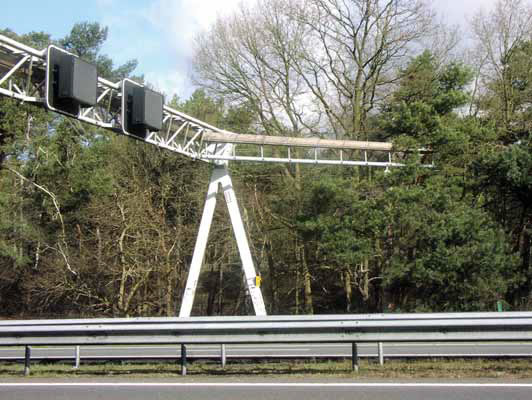
Figure 37. Photo. Canopy crossing installed in permanent signage fixture (Credit: Tony Clevenger).
 Figure 38. Photo. Ropes extending out from canopy crossing to forest canopy (Credit: Tony Clevenger).
Figure 38. Photo. Ropes extending out from canopy crossing to forest canopy (Credit: Tony Clevenger).
SUGGESTED DESIGN DETAILS
Crossing structure
- To ensure performance and function, canopy crossings should be situated in areas with high landscape permeability for target species, that are known corridors for cross-highway population connections, and that experience minimal human disturbance.
- If crossing structure consists of signage beam, >3 ropes should extend out from end of beam into nearest canopy to allow for animal access.
- For Flying Squirrels, trees in central median or landing post may be sufficient to allow travel across some highways without a canopy crossing structure.
Local habitat management
- Ensure that habitat around canopy crossing is managed for target species populations and their connectivity needs. Maintain continuity of habitat and canopy to allow target species to move throughout the area and access canopy crossing structure.
TYPES OF CONSTRUCTION
Diverse types of construction (rope, steel cable, wood platforms).
POSSIBLE VARIATIONS
- To minimize avian predation and provide greater protection for prey species using the canopy crossing an additional rope or cable can be placed above the devices used for travel.
MAINTENANCE
- Regular inspection and maintenance to avoid deterioration and wear of materials used for the canopy crossing (ropes, cables, attachments, wooden runways) and replacement of any components in poor condition.
SPECIES-SPECIFIC GUIDELINES
Recommended/Optimum solution for wildlife species/groups
Semi-arboreal mammals
- Species include: Tree Squirrels, Flying Squirrels, Fishers, Martens, Raccoons, Ringtails, Coatis and Opossums.
Possible if adapted to local conditions
Small mammals
- Some species with arboreal habits may use canopy crossings.
Not recommended or applicable
Ungulates
Carnivores (other than those listed above)
Low-mobility medium-sized mammals (other than those listed above)
Semi-aquatic mammals Amphibians
Reptiles
Unknown - more data are required
None
HOT SHEET 5: VIADUCT OR FLYOVER
GENERAL DESIGN
The viaduct, or flyover, is the largest of wildlife underpass structures; however, it is usually not built specifically for wildlife movement. The large span and clearance of viaducts shown in Figure 39 allow for use by a wide range of wildlife. Structures can be adapted for amphibians, semi-aquatic and semi-arboreal species. Viaducts with support pillars help keep habitats intact and nearly undisturbed. Viaducts also help restore or maintain hydrological flows and the biological diversity associated with riparian habitats. They are commonly used for crossing wetland habitats. A range of dimensions exist from long structures with low vertical clearance for wetlands to short structures with high clearance spanning deep canyons.

Figure 39. Photo. Viaduct as wildlife underpass (Credit: Ministère des Transports du Québec).
USE OF THE STRUCTURE
The viaduct is intended for wildlife, but may support occasional human use.
GENERAL GUIDELINES
- Viaducts are an alternative to constructing underpasses on cut-and-fill slopes, which tend to limit wildlife movement and reduce habitat connectivity compared to viaducts.
- Viaducts minimize the disturbance to habitats, vegetation, and riparian areas during construction. Design should be sufficiently wide enough to conserve riparian habitats and maintain local landform as in the Figure 40 example.
- Replant with local native vegetation if the area is disturbed during construction.
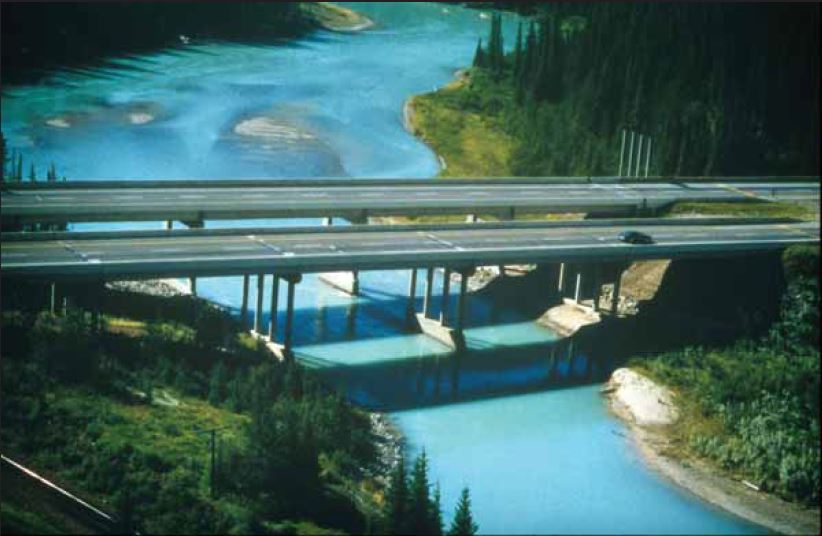
Figure 40. Photo. Wide span viaduct designed to conserve floodplain (Credit: Tony Clevenger).
DIMENSIONS - GENERAL GUIDELINES
Variable dimensions depending on location and terrain.
TYPES OF CONSTRUCTION
Concrete bridge span with support structures
Steel beam span
SUGGESTED DESIGN DETAILS
Crossing structure
- Areas under viaduct should be restored after construction with same vegetation in adjacent undisturbed areas leading up to the structure as shown in Figure 41. Effort should be made to reconstruct the habitat and eventually have continuous vegetation types and structure within and adjacent to the viaduct.

Figure 41. Photo. Viaduct with retention of riparian vegetation (Credit: Tony Clevenger).
- Ponds or wetland habitat may be constructed connecting isolated habitats for amphibian species.
- Stringers of brush and root wads can be used to provide cover and microhabitat for cover- dwelling species until native vegetation can be restored to area.
- Drainage is generally not a problem if spanning water courses, however, riparian habitats should be protected as best as possible during and after construction. Pillars should avoid impacting riparian habitats completely, being outside the high-water mark.
Local habitat management
- If wildlife fencing is used below viaduct to funnel animals, then fencing should tie into the support structures or be close as possible to side slopes, thus providing the widest area for wildlife passage.
- Human use and any signs of human presence (e.g., storage of materials) should be minimized around viaducts.
POSSIBLE VARIATIONS
- Road construction and operation should be avoided if at all possible underneath viaducts that are adapted for wildlife use. If roads are necessary, they should have low traffic volumes and be placed to one side of the viaduct. Trees, shrubs and other shielding devices should be used to reduce any impacts of vehicle disturbance to wildlife use of the site.
- Some viaducts spanning wetlands may have sound-attenuating walls to reduce traffic noise or disturbance to adjacent habitat. In these cases, walls should not be transparent. If they are, they should have proper markings to adequately warn birds of their presence. Poles have been used effectively on bridges to deflect terns flying over a viaduct.
MAINTENANCE
- Inspections should be made periodically to ensure that there are no obstructions to wildlife movement below the viaduct.
- While restoring native vegetation, periodic checks should be made to ensure that vegetation is properly cared for and there is adequate water or fertilizer for vegetation to grow.
- Sound-attenuating walls should be inspected and repaired as necessary.
SPECIES-SPECIFIC GUIDELINES
Recommended/Optimum solution for wildlife species/groups
Ungulates
- Species will vary based on structure dimensions
Carnivores
- Species will vary based on structure dimensions
- Fisher, Marten, Badger, Weasel
Low-mobility medium-sized mammals
Small mammals
Reptiles
Possible if adapted to local conditions
Semi-arboreal mammals
- Tend to prefer arboreal habitats with structure that provides cover and protection during travel. Providing cover and escape or refuge areas such as piles of brush, stones or large woody debris should help movement under structure and between preferred habitats.
Semi-aquatic mammals
- Mink, River Otter, Muskrats and other riparian-associated species will use if riparian habitat is present or nearby.
Amphibians
- Not likely to use structure unless located within or adjacent to their preferred habitats, in a migratory route, or during dispersal. Amphibian habitat can be created with series of ponds in a stepping-stone pattern connecting wetland habitats separated by highway Figure 42 provides an example of this pattern on a wildlife overpass.
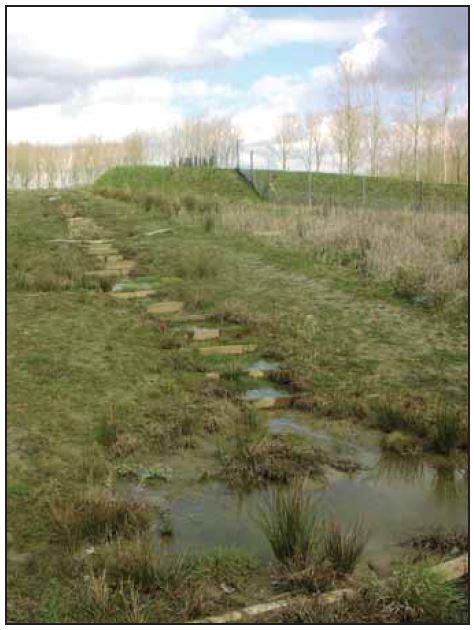
Figure 42. Photo. "Stepping stone" ponds on wildlife overpass used to assist amphibian movement (Credit: Tony Clevenger).
Not recommended or applicable
None
Unknown - more data are required
None
HOT SHEET 6: LARGE MAMMAL UNDERPASS
GENERAL DESIGN
The large mammal underpass is not as large as most viaducts, but is the largest of underpass structures designed specifically for wildlife use. It is primarily designed for large mammals, but use by some large mammals will depend largely on how it may be adapted for their specific crossing requirements. Small- and medium-sized mammals (including carnivores) generally utilize these structures, particularly if cover is provided along walls of the underpass by using brush or root wads. These underpass structures can be readily adapted for amphibians, semi- aquatic and semi-arboreal species.
USE OF THE STRUCTURE
The large mammal underpass is designed exclusively for use by wildlife.
GENERAL GUIDELINES
- Being generally smaller than a viaduct or flyover, the ability to restore habitat underneath will be limited. Open designs that provide ample natural lighting will encourage greater development of native vegetation as shown in Figure 43.
- To ensure performance and function, large mammal underpasses should be situated in areas with high landscape permeability and that are known wildlife travel corridors and experience minimal human disturbance.
- Motor vehicle or all-terrain vehicle use should be prohibited. Eliminating public or any other human use, activity or disturbance at the underpass and adjacent area is recommended for its proper function and for maximizing wildlife use.
- Underpass should be designed to conform to local topography. Design drainage features so flooding does not occur within the underpass as Figure 44 shows. Run-off from highway near structure should not be directed toward the underpass.
- Maximize continuity of native soils adjacent to and within the underpass. Avoid importation of soils from outside the project area.
DIMENSIONS - GENERAL GUIDELINES
Width:
Minimum: 20 ft (7 m)
Recommended: >40 ft (>12 m)
Height:
Minimum: 10 ft (4 m)
Recommended: >15 ft (>4.5 m)
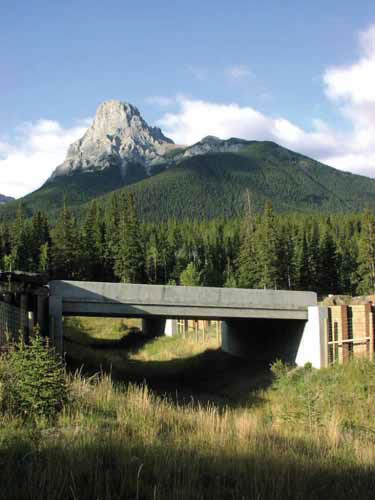
Figure 43. Photo. Open span wildlife underpass (Credit: Tony Clevenger).
TYPES OF CONSTRUCTION
Span
Concrete bridge span (open span bridge)
Steel beam span
Arch
Concrete bottomless arch
Corrugated steel bottomless (footed?) arch
Elliptical multi-plate corrugated steel culvert
Box culvert
Prefabricated concrete
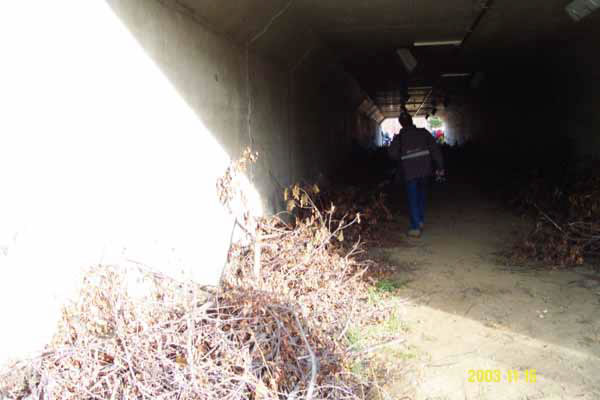
Figure 44. Photo. Brush and root wads placed along underpass wall to provide cover for mammals (Credit: Nancy Newhouse).
SUGGESTED DESIGN DETAILS
Crossing structure
- Structures should be designed to meet the movement needs of the widest range of species possible that live in the area or might be expected to recolonize the area, e.g., high- and low-mobility species.
- Attempt to mirror habitat conditions found on both sides of the road and provide continuous habitat adjacent to and within the structure.
- Maximize microhabitat complexity and cover within the underpass using salvage materials (logs, root wads, rock piles, boulders, etc.) to encourage use by semi-arboreal mammals, small mammals, reptiles and species associated with rocky habitats as Figure 44 showed.
- It is preferable that the substrate of underpass is of native soils. If construction type has closed bottom (e.g., concrete box culvert), a soil substrate > 6 in (15 cm) deep must be applied to interior.
- Revegetation is possible in areas of underpass closest to the entrance. Light conditions tend to be poor in the center of the structure.
- Design underpass to minimize the intensity of noise and light coming from the road and traffic.
Local habitat management
- Protect existing habitat. Design with minimal clearing widths to reduce impacts on existing vegetation. Where habitat loss occurs, reserve all trees, large logs, and root wads to be used adjacent to and within underpass.
- Wildlife fencing is the most effective and preferred method to guide wildlife to the structure and prevent intrusions onto the right-of-way. Mechanically stabilized earth (MSE) walls, if high enough, can substitute for fencing and is not visible to motorists.
- Encourage use of underpass by either baiting or cutting trails leading to structure, if appropriate.
- Avoid building underpass in location with road running parallel and adjacent to entrance, as it will affect wildlife use.
- If traffic volume is high on the road above the underpass it is recommended that sound attenuating walls be placed above the entrance to reduce noise and light disturbance from passing vehicles.
- Underpass must be within cross-highway habitat linkage zone and connect to larger corridor network.
- Existing or planned human development in adjacent area must be at sufficient distance to not affect long-term performance of underpass. Long-range planning must ensure that adjacent lands will not be developed and the wildlife corridor network is functional.
POSSIBLE VARIATIONS
Divided road (two structures)
In-line:
Off-set:
Undivided road (one structure)
MAINTENANCE
- If wildlife underpass is not being monitored on regular basis, periodic visits should be made to ensure that there are no obstacles or foreign matter in or near the underpass that might affect wildlife use.
- Fence should be checked, maintained and repaired periodically (minimum once per year, preferably twice per year).
SPECIES-SPECIFIC GUIDELINES
Recommended/Optimum solution for wildlife species/groups
Ungulates
Carnivores
- Black bear, Coyote, Fox1, Cougar, Bobcat
Low-mobility medium-sized mammals
- For maximum use, cover and protection should be provided in form of rocks, logs, brush or root wads placed along one or both walls. Cover should be continuous within and adjacent to underpass.
Small mammals
- Same as for low-mobility medium-sized mammals
Reptiles
- Same as above for low-mobility medium-sized mammals
Possible if adapted
Ungulates
- Moose - Tend to prefer large, open structures with good visibility and vertical clearance. Recommended dimensions may not be sufficient to ensure regular use by individuals of all gender and age classes. Recommend minimum 40 ft (12 m) width and 15 ft (4.5 m) height.
- Bighorn Sheep, Mountain Goat - Like Moose, tend to prefer large, open structures with good visibility. Recommended dimensions may not be sufficient to ensure regular use by individuals of all gender and age classes. Recommend minimum 40 ft (12 m) width and 15 ft (4.5 m) height.
Carnivores
- Grizzly Bear, Wolf - Tend to prefer large, open structures with good visibility, such as landscape bridges, wildlife overpasses or viaducts. Recommended dimensions may not be sufficient to ensure regular use by individuals of all gender and age classes. Recommend minimum 40 ft (12 m) width and 15 ft (4.5 m) height.
- Fox2 - Species adapted to arid, open grassland habitats that generally experience high levels of mortality from roads and larger predators (e.g., Coyotes). Few documented cases of Swift/Kit Foxes using wildlife crossings, suggesting they avoid them and prefer to cross at grade-level. To encourage Fox use of structures they should be designed for their body size. Small- and medium-sized mammals, particularly prey species, tend to use passages of a size that allow for their movement, but may limit movement of their larger predators. Hinged iron gates can be placed on underpass entrance. A 6 in x 6 in (15 x 15 cm) mesh spacing on gates will allow foxes to pass through but not the larger predators. In larger structures (e.g., 4 ft x 4 ft (1.2 x 1.2 m) culvert), artificial dens should be installed within structures and near entrances to provide escape cover for Swift/Kit Foxes.
- Fisher, Marten - Forest-dwelling species that tend to prefer structures with ample vegetative cover or form of protection while traveling. Recommended to place brush or root wads along underpass wall (one wall is sufficient; two is preferred but will depend on width of structures) to ensure regular use by individuals of all gender and age classes. In large underpasses, culvert or pipes can be placed to provide cover.
- Badger, Weasel sp. - Species adapted to open habitats and require subterranean burrows for protection. Recommended to place brush or root wads along underpass wall (one wall is sufficient; two is preferred but will depend on width of structures) to ensure regular use by individuals of all gender and age classes. In large underpasses, culvert or pipes can be placed to provide cover.
Semi-arboreal mammals
- Tend to prefer arboreal habitats with structure that provides cover and protection during travel. Providing cover and escape or refuge areas such as piles of brush, stone or large woody debris should help movement under structure and between preferred habitats.
Semi-aquatic mammals
- Mink, River Otter, Muskrats and other riparian-associated species may be reluctant to use a wildlife underpass unless riparian habitat is present or nearby. The construction of amphibian habitat may facilitate crossings by species associated with those habitat types. See Figure 32 shown earlier for an example of amphibian habitat constructed on a wildlife overpass.
Amphibians
- Not likely to use structure unless located in migratory route or during dispersal. Amphibian habitat can be created with series of ponds in a stepping-stone pattern connecting wetland habitats separated by highway. See Figure 42 shown earlier for an example of this pattern on a wildlife overpass.
Not recommended or applicable
None
Unknown - more data are required
Pronghorn
- Little information available on wildlife crossing design needs of this species. Most reports indicate that good visibility is critical and overpass structures are preferred. However, recently this species has been detected using a large span underpass structure in California.
Lynx
- Similar to Pronghorn, scarce data exist on what type of crossings Lynx will use. Monitoring of wildlife crossings on the Trans-Canada Highway in Banff National Park and adjacent provincial lands have detected Canada Lynx using a range of structure types on the Trans-Canada Highway: 165 ft (50-m) wide overpass, open span bridge underpass (40 ft [12 m] wide x 13 ft [4 m] high).
Wolverine
- The only data at time of writing on Wolverine use of wildlife crossing structures comes from Banff National Park and adjacent Bow Valley Provincial Park. Wolverine have been documented using the following:
- Underpass with Waterflow - Open span bridge with creek
- Width: 37 ft (11.5 m)
Height: 8.2 ft (2.5 m)
Usage: 3 detections
- Large Mammal Underpass - Open span bridge
- Width: 42.5 ft (13 m)
Height: 16.5 ft (5.0 m)
Usage: 1 detection
- Large Mammal Underpass - Multi-plate elliptical culvert
- Width: 24 ft (7.2 m)
Height: 3 ft (4 m)
Usage: 1 detection
HOT SHEET 7: MULTI-USE UNDERPASS
GENERAL DESIGN
A multi-use underpass is similar in design to a large mammal underpass, however the management objective is to allow co-use between wildlife and humans. These structures can be retrofit bridges for wildlife passage or designed specifically for co-use as Figure 45 illustrates. They may be adequate for movement of some large mammals, but not all wildlife. Small- and medium-sized mammals will utilize the structures, particularly generalist species common in human-dominated environments (e.g., urban habitats). Structures may be able to be adapted for semi-arboreal species. Semi-aquatic and amphibian species may use them if they are located within their habitats.
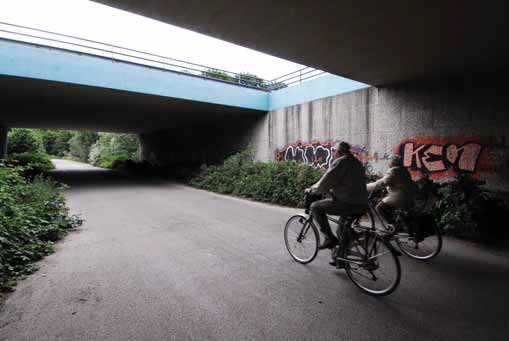
Figure 45. Photo. Multi-use underpass in The Netherlands retrofitted for human use and wildlife passage (Credit: Marcel Huijser).
USE OF THE STRUCTURE
Multi-use underpasses are designed for mixed wildlife and human use (recreational, agricultural, etc.).
GENERAL GUIDELINES
- Being generally smaller than a viaduct or large mammal underpass, the ability to restore habitat underneath will be limited. Open designs that provide ample natural lighting will encourage greater development of native vegetation.
- May be located in prime wildlife habitat, but generally are near human use areas.
- If the structure is > 40 ft (>12 m) wide, human use (e.g., paths, riding trails) should be confined to one side, leaving greater space for wildlife use. Vegetation can be used to shield human use from wildlife.
- Frequent motor vehicle or all-terrain vehicle (ATV) use of underpass should be discouraged. High levels of disturbance from ATVs or other motorized vehicles at the underpass and adjacent area will likely disturb most wildlife in the area and negatively affect the ability of wildlife to use underpass for cross-road movements.
- Low-level vehicular traffic is acceptable through the underpass, e.g., rural or agricultural use. Keep the road unpaved and its margin vegetated providing continuity through the underpass and adjacent habitats.
- Underpass should be designed to conform to local topography. Design drainage features so flooding does not occur within the underpass. Run-off from highway near structure should not be directed toward the underpass.
- Maximize continuity of native soils adjacent to and within the underpass. Avoid importation of soils from outside the project area.
DIMENSIONS - GENERAL GUIDELINES
Width:
Minimum: 16.5 ft (5 m)
Recommended: >23 ft (>7 m)
Height:
Minimum: 8.2 ft (2.5 m)
Recommended: >11.5 ft (>3.5 m)
TYPES OF CONSTRUCTION
Concrete bottomless arch
Concrete bridge span (open span bridge)
Steel beam span
Elliptical multi-plate metal culvert
Prefabricated concrete box culvert
SUGGESTED DESIGN DETAILS
Crossing structure
- Attempt to mirror habitat conditions found on both sides of the road and provide continuous habitat adjacent to and within the structure.
- Revegetation is possible in areas of the underpass closest to entrances, as light conditions tend to be better than in the center of the structure.
- Design underpass to minimize the intensity of noise and light coming from the road and traffic.
- Maximize microhabitat complexity and cover within the underpass using salvage materials (logs, root wads, rocks, etc.) to encourage use by semi-arboreal mammals, small mammals, reptiles, and species associated with rocky habitats.
- It is preferable that the substrate of the underpass is of native soils. If the design has a closed bottom (e.g., concrete box culvert), a soil substrate > 6 in (15 cm) deep must be applied to the underpass interior.
- If rural traffic uses the underpass, do not install curbs or elevated margins of road that separate areas of vehicular use from wildlife use. The transition between the two areas should be natural and not present obstacles.
- Depending on the width of the underpass with vehicular traffic, wildlife paths could run along both sides (of a wide underpass) or along one side (of a narrow underpass); regardless of configuration, the wildlife paths should be > 8 ft (2.4 m) wide.
Local habitat management
- Protect existing habitat. Design with minimal clearing widths to reduce impacts on existing vegetation. Where habitat loss occurs, reserve all trees, large logs, and root wads to be used adjacent to and within the underpass.
- Wildlife fencing is the most effective and preferred method to guide wildlife to the structure and prevent intrusions onto the right-of-way.
- Discourage building underpass in location with a road running parallel and adjacent to the entrance, as it will affect wildlife use.
- If traffic volume is high on the road above the underpass it is recommended that sound- attenuating walls be placed above the entrance to reduce noise and light disturbance from passing vehicles.
POSSIBLE VARIATIONS
Divided road (2 structures)
In-line:
Off-set:
Undivided road (1 structure)
MAINTENANCE
- If wildlife underpass is not being monitored on a regular basis, periodic visits should be made to ensure that there are no obstacles or foreign matter in or near the underpass that might affect wildlife use.
- Fence should be checked, maintained and repaired periodically (minimum once per year, preferably twice per year).
SPECIES-SPECIFIC GUIDELINES
Recommended/Optimum solution for wildlife species/groups
Ungulates
Carnivores
- Coyote, Fox1, Bobcat, Fisher, Marten, Weasel, Badger
Low-mobility medium-sized mammals
Small mammals
Reptiles
Possible if adapted
Carnivores
- Fox2 - Species adapted to arid, open grassland habitats that generally experience high levels of mortality from roads and larger predators (e.g., Coyotes). Few documented cases of Swift/Kit Foxes using wildlife crossings, suggesting they avoid them and prefer to cross at grade-level. To encourage Fox use of structures they should be designed for their body size. Small- and medium-sized mammals, particularly prey species, tend to use passages of a size that allow for their movement but may limit movement of their larger predators. Hinged iron gates can be placed on underpass entrance. A 6 in x 6 in (15 x 15 cm) mesh spacing on gates will allow Foxes to pass through but not the larger predators. In larger structures (e.g., a 4 ft x 4 ft [1.2 x 1.2 m] culvert) artificial dens should be installed within structures and near entrances to provide escape cover for Swift/Kit Foxes.
Semi-arboreal mammals
- Tend to prefer arboreal habitats with structure that provides cover and protection during travel. Providing cover and escape or refuge areas such as piles of brush, stone or large woody debris should help movement under structure and between preferred habitats.
Semi-aquatic mammals
- Mink, River Otter, Muskrats and other riparian-associated species may be reluctant to use a wildlife underpass unless riparian habitat is present or nearby. The construction of amphibian habitat may facilitate crossings by species associated with those habitat types.
Amphibians
- Not likely to use structure unless located in migratory route or during dispersal. Amphibian habitat can be created with series of ponds in a stepping-stone pattern connecting wetland habitats separated by highway.
Not recommended or applicable
Ungulates
- Moose, Pronghorn, Bighorn Sheep, Mountain Goat
Carnivores
- Black Bear, Grizzly Bear, Wolf, Cougar, Lynx, Wolverine
Unknown - more data are required
None
HOT SHEET 8: UNDERPASS WITH WATERFLOW GENERAL DESIGN
Underpass structures like those in Figure 46 can be designed to accommodate dual needs of moving water and wildlife. Structures are generally located in wildlife movement corridors given their association with riparian habitats; however, some maybe only marginally important. Structures aimed at restoring proper function and connection of aquatic and terrestrial habitats should be situated in areas with high landscape permeability, are known wildlife travel corridors and have minimal human disturbance. These underpass structures are frequently used by several large mammal species, yet use by some large mammals will depend largely on how it may be adapted for their specific crossing requirements. Small- and medium-sized mammals (including carnivores) generally utilize these structures, particularly if riparian habitat is retained or cover is provided along walls of the underpass by using logs, brush or root wads. These underpass structures can be readily adapted for amphibians, semi-aquatic and semi-arboreal species.
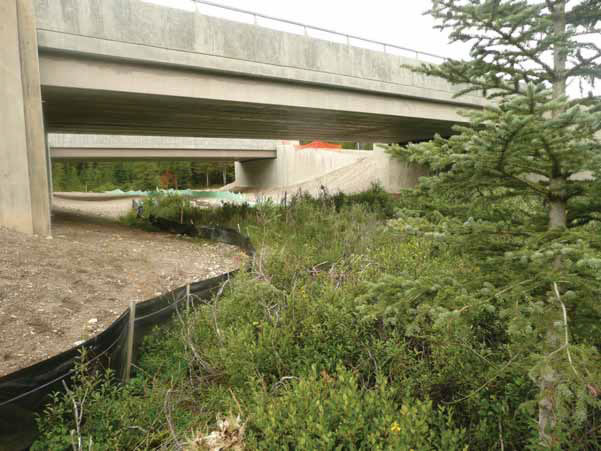
Figure 46. Photo. Wildlife underpass designed to accommodate waterflow (Credit: Tony Clevenger).
USE OF THE STRUCTURE
Exclusively for wildlife, but may have some human use
GENERAL GUIDELINES
- Underpass structure should span the portion of the active channel migration corridor of unconfined streams needed to restore floodplain, channel and riparian functions.
- If underpass structure covers a wide span, support structures should be placed outside the active channel.
- Design underpass structure with minimal clearing widths to reduce impacts on existing vegetation.
- Even with large span structures the ability to restore habitat underneath will be limited. Open designs that provide ample natural lighting will encourage greater development of important native riparian vegetation.
- Maximize the continuity of native soils adjacent to and within the underpass. Avoid importation of soils from outside project area.
- Motor vehicle or all-terrain-vehicle use should be prohibited. Eliminating public or any other human use, activity or potential disturbance at the underpass and adjacent area is recommended for proper function and maximizing wildlife use.
- Underpass should be designed to conform to local topography. Design drainage features' so flooding does not occur within underpass. Run-off from highway near structure should not end up in underpass.
DIMENSIONS - GENERAL GUIDELINES
Dimensions will vary depending on width of active channel of waterflow (creek, stream, river). Guidelines are given below for dimensions of wildlife pathway alongside active channel and height of underpass structure.
Minimum:
Width: 6.5 ft (2 m) pathway
Height: 10 ft (3 m)
Recommended:
Width: >10 ft (>3 m) pathway
Height: >13 ft (>4 m)
TYPES OF CONSTRUCTION
Concrete bridge span (open span bridge)
Steel beam span
Concrete bottomless arch
SUGGESTED DESIGN DETAILS
Crossing structure
- Structures should be designed to meet the movement needs of widest range of species possible that live in the area or might be expected to recolonize the area, e.g., high and low mobility species.
- Attempt to mirror habitat conditions found on both sides of the road and provide continuous riparian habitat adjacent to and within the structure.
- Maximize microhabitat complexity and cover within underpass using salvage materials (logs, root wads, rock piles, etc.) to encourage use by semi-arboreal mammals, small mammals, reptiles and species associated with rocky habitats.
- Preferable that the substrate of underpass is of native soils.
- Revegetation will be possible in areas of underpass closest to the entrance, as light conditions tend to be poor in the center of the structure.
- Design underpass to minimize the intensity of noise and light coming from the road and traffic.
Local habitat management
- Protect existing habitat. Design with minimal clearing widths to reduce impacts on existing vegetation. Where habitat loss occurs, reserve all trees, large logs, and root wads to be used adjacent to and within underpass.
- Wildlife fencing is most effective and preferred method to guide wildlife to structure and prevent intrusions to the right-of-way. Mechanically stabilized earth (MSE) walls like the one in Figure 47, if high enough, can substitute for fencing and is not visible to motorists.
- Encourage use of underpass by either baiting or cutting trails leading to structure, if appropriate.
- Avoid building underpass in location with road running parallel and adjacent to entrance, as it will affect wildlife use.
- If traffic volume is high on the road above the underpass it is recommended that sound attenuating walls be placed above the entrance to reduce noise and light disturbance from passing vehicles.
- Underpass must be within cross-highway habitat linkage zone and connects to larger corridor network.
- Existing or planned human development in adjacent area must be at sufficient distance to not affect long-term performance of underpass. Long-range planning must ensure that adjacent lands will not be developed and the wildlife corridor network is functional.
POSSIBLE VARIATIONS
Divided road (2 structures)
In-line:
Undivided road (1 structure)
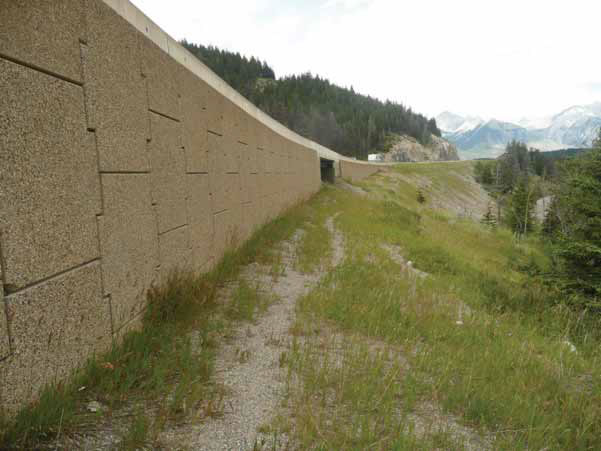
Figure 47. Photo. Mechanically stabilized earth (MSE) wall serving as wildlife exclusion "fence" (Credit: Tony Clevenger).
MAINTENANCE
- If wildlife underpass is not being monitored on regular basis, periodic visits should be made to ensure that there are no obstacles or foreign matter in or near the underpass that might affect wildlife use.
- Fence should be checked, maintained and repaired periodically (minimum once per year, preferably twice per year).
SPECIES-SPECIFIC GUIDELINES
Recommended/Optimum solution for wildlife species/groups
Ungulates
Carnivores
- Black Bear, Coyote, Fox1, Cougar, Bobcat
Low mobility medium-sized mammals
- Providing cover within underpass by using salvage materials (logs, root wads, rocks, etc.) will encourage use by these species.
Semi-aquatic mammals
- Mink, River Otter, Muskrats and other riparian-associated species may be reluctant to use a wildlife underpass unless riparian habitat is present or nearby. Recommended maintaining riparian vegetation through the wildlife underpass to ensure use and regular movement by these species.
Small mammals
- Providing cover within underpass by using salvage materials (logs, root wads, rocks, etc.) will encourage use by these species.
Possible if adapted
Ungulates
- Moose - Tend to prefer large, open structures with good visibility and vertical clearance. The dimensions of some smaller underpasses may not be sufficient to ensure regular use by individuals of all sex and age classes. Recommend minimum 40 ft (12 m) width and 15 ft (4.5 m) height.
- Pronghorn, Bighorn Sheep, Mountain Goat - Like Moose, these species tend to prefer large, open structures with good visibility. Dimensions of some underpasses may not be sufficient to ensure regular use by individuals of all gender and age classes. Recommend minimum 40 ft (12 m) width and 15 ft (4.5 m) height for Bighorn Sheep and Mountain Goat; Recommended minimum 65 ft (20 m) width and 15 ft (4.5 m) height for Pronghorn.
Carnivores
- Grizzly Bear, Wolf - Tend to prefer large, open structures with good visibility, such as landscape bridges, wildlife overpasses and viaducts. Recommended dimensions may not be sufficient to ensure regular use by individuals of all gender and age classes. Recommend minimum 40 ft (12 m) width and 15 ft (4.5 m) height.
- Fox2 - Species adapted to arid, open grassland habitats that generally experience high levels of mortality from roads and larger predators (e.g., Coyotes). Few documented cases of Swift/Kit Foxes using wildlife crossings, suggesting they avoid them and prefer to cross at grade-level. To encourage Fox use of structures they should be designed for their body size, to limit predation risks associated with the crossings. It is unlikely these structures be designed specifically for Swift/Kit Fox use, thus wide and high underpasses with good visibility for prey species would be the most effective. In larger structures artificial dens should be installed within structures and near entrances to provide escape cover for Swift/Kit Foxes.
- Fisher, Marten - Forest-dwelling species that tend to prefer structures with ample riparian habitat, vegetative cover or form of protection while traveling. Recommended to place brush or root wads along underpass wall (one wall is sufficient; two is preferred, but will depend on width of structure) to ensure regular use by individuals of all gender and age classes. In large underpasses, culvert or pipes can be placed to provide cover.
- Badger, Weasel sp. - Species adapted to open habitats and require subterranean burrows for protection. Recommended to place brush, root wads along underpass wall (one wall is sufficient; two is preferred, but will depend on width of structure) to ensure regular use by individuals of all gender and age classes. In large underpasses, culvert or pipes can be placed to provide cover as Figure 48 shows.
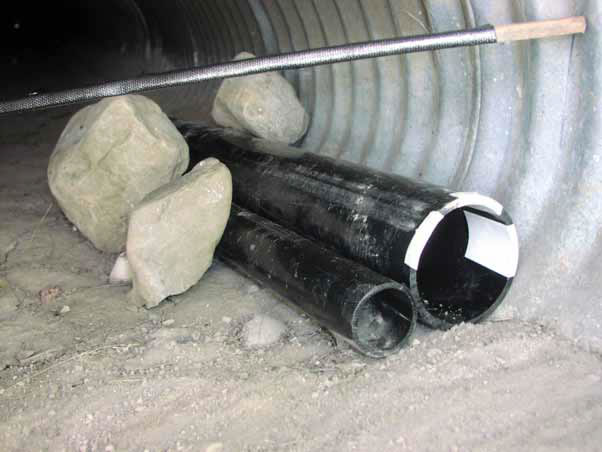
Figure 48. Photo. Pipes placed in culverts to provide cover for small mammal movement (Credit: Tony Clevenger).
Semi-arboreal mammals
- Tend to prefer arboreal habitats with structure that provides cover and protection during travel. Providing cover and escape or refuge areas such as piles of brush, stone or large woody debris should help movement under structure and between preferred habitats.
Amphibians
- Not likely to use structure unless located in migratory route or during dispersal. Amphibian habitat can be created with series of ponds in a stepping-stone pattern connecting wetland habitat separated by highway shown previously in Figure 42 as an example for wildlife overpass. Recommended maintaining riparian vegetation, soil moisture and natural light conditions throughout the wildlife underpass to ensure use and regular movement by the species of concern.
Not recommended or applicable
None
Unknown - more data are required
Lynx
Similar to Pronghorn, scarce data exist on what type of crossings Canada Lynx will use. Monitoring of wildlife crossings on the Trans-Canada Highway in Banff National Park and adjacent provincial lands have detected Canada Lynx using a range of structure types on the Trans-Canada Highway: 165 ft (50-m) wide overpass, open span bridge underpass (40 ft [12 m] wide x 13 ft [4 m] high). For this species, recommendations are to design large structures but more importantly provide cover in form of logs, brush or root wads within the underpass. Siting the crossing within suitable Lynx habitat will be critical for successful design and use by Lynx.
Wolverine
The only data on Wolverine use of a wildlife crossing comes from Banff National Park and adjacent Bow Valley Provincial Park. Wolverine have been documented using the following:
- Underpass with Waterflow - Open span bridge with creek
- Width: 37 ft (11.5 m)
Height: 8.2 ft (2.5 m)
Usage: 3 detections
- Large Mammal Underpass - Open span bridge
- Width: 42.5 ft (13 m)
Height: 16.5 ft (5.0 m)
Usage: 1 detection
- Large Mammal Underpass - Multi-plate elliptical culvert
- Width: 24 ft (7.2 m)
Height: 3 ft (4 m)
Usage: 1 detection
For this species, recommendations are to design large structures but more importantly provide cover in form of logs, brush or root wads within the underpass. Similar to Canada Lynx, siting the crossing within suitable Wolverine habitat will be critical for successful design and use by this species.
HOT SHEET 9: SMALL-TO-MEDIUM-SIZED MAMMAL UNDERPASS
GENERAL DESIGN
One the smallest wildlife crossing structures. Primarily designed for small- and medium-sized mammals, but use by most species will depend largely on how it may be adapted for their specific crossing requirements and cover needs as Figure 49 shows. Small- and medium-sized mammals (including carnivores) generally utilize these structures, particularly if they provide sufficient cover and protection. These underpass structures can be of value to semi-aquatic mammals and amphibians if underpass structure is located in or near the habitat of these species.
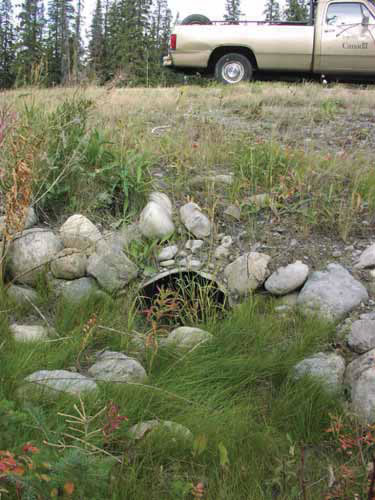
Figure 49. Photo. Small- to medium-sized mammal underpass (Credit: Tony Clevenger).
USE OF THE STRUCTURE
Exclusively for wildlife
GENERAL GUIDELINES
- To ensure performance and function, small to medium-sized mammal underpasses should be situated in areas with high landscape permeability, are known wildlife travel corridors and have minimal human disturbance.
- Underpass should be designed to conform to local topography. Design drainage features so flooding does not occur within underpass. Run-off from highway near structure should not end up in underpass.
DIMENSIONS - GENERAL GUIDELINES
Dimensions will vary depending on the target species. Structures generally range from 1 ft to 4 ft (0.4-1.2 m) diameter culverts or underpass structures.
TYPES OF CONSTRUCTION
Concrete bottomless arch
Circular multi-plate metal culvert
Prefabricated concrete box culvert
SUGGESTED DESIGN DETAILS
Crossing structure
- Structures should be designed to meet the movement needs of widest range of species possible that live in the area or might be expected to recolonize area, e.g., high and low mobility species.
- Maximize microhabitat complexity and cover within underpass using salvage materials (logs, root wads, rock piles, etc.) for sustained use by semi-arboreal mammals, small mammals, reptiles and species associated with rocky habitats.
- Preferable that the substrate of larger underpasses is of native soils. If construction type has closed bottom (e.g., concrete box culvert), a soil substrate > 6 in (15 cm) deep must be applied to interior.
- Design underpass to minimize the intensity of noise and light coming from the road and traffic.
- On divided highways, underpass structure should be continuous, below-grade and not open up in the central median as the example in Figure 50 shows.
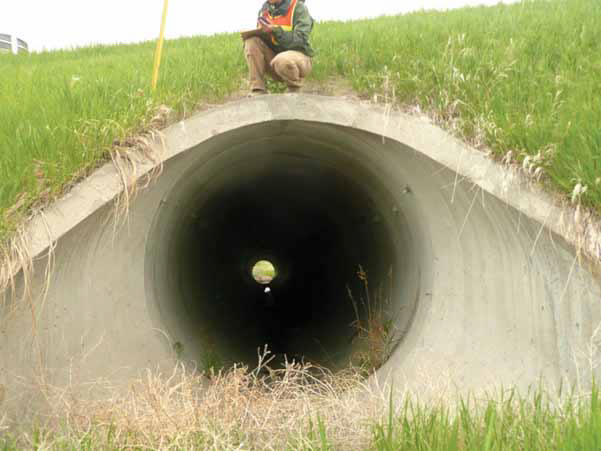
Figure 50. Photo. Continuous wildlife underpass on divided highway (Credit: Tony Clevenger).
Local habitat management
- Protect existing habitat. Design with minimal clearing widths to reduce impacts on existing vegetation. Where habitat loss occurs, reserve all trees, large logs, and root wads to be used adjacent to and within larger wildlife crossing structures that may be built during project.
- Attempt to provide continuous habitat leading to and adjacent to the structure.
- Encourage use of structure by using fencing, rock walls, or other barriers along road to direct wildlife into underpass. Use topography and natural features as much as possible.
- Encourage use of underpass by baiting and/or cutting trails leading to structure, if appropriate.
- Avoid building underpass in location with road running parallel and adjacent to entrance, as it will affect wildlife use.
- If traffic volume is high on the road above the underpass it is recommended that sound attenuating walls be place above the entrance to reduce noise and light disturbance from passing vehicles.
POSSIBLE VARIATIONS
Divided road (2 structures)
In-line:
Off-set:
Undivided road (1 structure)
MAINTENANCE
- If wildlife underpass/culvert is not being monitored on regular basis, periodic visits should be made to ensure that there are no obstacles or foreign matter in or near the underpass that might affect wildlife use.
- Fence should be checked, maintained and repaired periodically (minimum once per year, preferably twice per year).
SPECIES-SPECIFIC GUIDELINES
Recommended/Optimum solution for wildlife species/groups
Carnivores
- Coyote, Fox1 - Generalist species' that occupy a variety of habitat types. Will typically use underpass or culvert designs sufficiently large enough so they can move through them.
- Fisher, Marten - Forest-dwelling species that tend to prefer structures that provide or have cover elements incorporated. Marten are known to readily use drainage culverts to cross 2- and 4-lane roads as captured in Figure 51. There is only anecdotal information on Fishers using drainage culverts. Design of culverts for these mustelid species should be slightly larger than their body size (ca. 2-3 ft diameter), thus providing cover and protection needed for travel. Larger size underpass structures should have continuous cover throughout to ensure regular use by individuals of all gender and age classes.
- Badger, Weasel - Species generally found in open areas and have been documented using drainage culverts to cross roads. Like Martens, Weasels readily use drainage culverts, particularly smaller ones (ca. 2 ft diameter). Badger tunnels have been designed in many countries and shown to be successful mitigation measures as shown in Figure 52. Design of tunnels or culverts for these species should be slightly larger than their body size (badgers, 2-3 ft (0.6-0.9 m) diameter; weasels, 1-2 ft (0.3-0.6 m) diameter), thus providing cover and protection needed for travel. Larger size underpass structures will not likely be sufficient to ensure regular use by individuals of all gender and age classes unless cover is added to them.
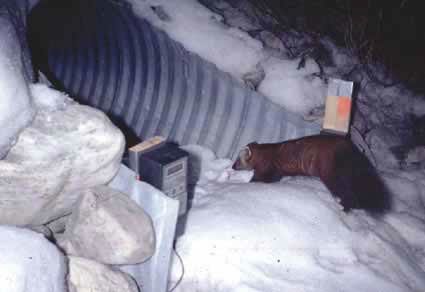
Figure 51. Photo. American marten using a drainage culvert to cross the Trans-Canada Highway, Banff National Park, Alberta (Credit: Tony Clevenger).
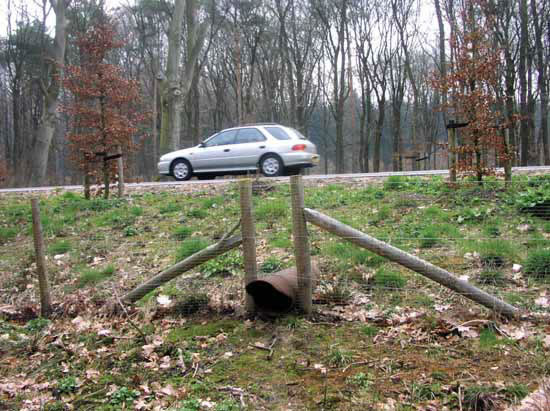
Figure 52. Photo. Badger tunnel in The Netherlands (Credit: Tony Clevenger).
Low mobility medium-sized mammals
- To encourage use from these species, structures should be designed for their body size. Small- and medium-sized mammals, particularly prey species, tend to use passages of a size that allow for their movement but may limit movement of their larger predators. In larger culverts (e.g., >4 ft (1.2 m) diameter circular or 4 ft x 4 ft [1.2 x 1.2 m] box culverts) the cover requirements of smaller fauna maybe met by placing pipes of varying diameter in the culvert that span the entire length.
Small mammals - (same as above for Low mobility medium-sized mammals)
Reptiles - (same as above for Low mobility medium-sized mammals)
Possible if adapted
Carnivores
- Fox2 - Species adapted to arid, open grassland habitats that generally experience high levels of mortality from roads and larger predators (e.g., Coyotes). Few documented cases of Foxes using a range of wildlife crossing sizes, but generally avoid them preferring to cross at grade-level. Design of culverts for these species should follow guidelines for Low mobility medium-sized mammals above. In larger structures (ca. 4 ft x 4 ft [1.2 x 1.2 m] culvert) artificial dens should be installed within structures and near entrances to provide escape cover for Swift/Kit Foxes generally shown in Figure 53.
Semi-aquatic mammals
- Mink, River Otter, Muskrats and other riparian-associated species may be reluctant to use a wildlife underpass unless riparian habitat is present or nearby. Efforts should be made to site underpass structure in most suitable habitat for these species.
Amphibians
- Not likely to use crossing structure unless located in migratory route or in general area where dispersal may occur. Efforts should be made to site underpass structure in known routes of seasonal migration, dispersal or other movement events for the target species.
Not recommended or applicable
Ungulates
- Moose, Elk, Deer, Pronghorn, Bighorn Sheep, Mountain Goat
Carnivores
- Black Bear, Grizzly Bear, Wolf, Cougar, Bobcat, Lynx, Wolverine
Semi-arboreal mammals - all species.
Unknown - more data are required
None
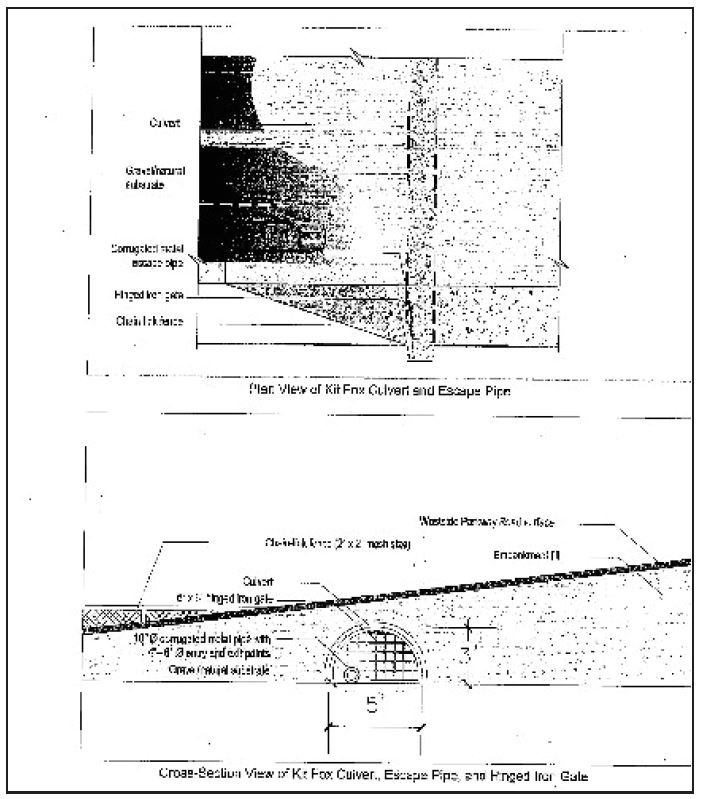
Figure 53. Schematic. Technical design plan for artificial kit fox den in culvert (Credit: US Fish and Wildlife Service).
View larger version of Figure 53.
HOT SHEET 10: MODIFIED CULVERT
GENERAL DESIGN
A crossing that is adaptively designed for use primarily by small and medium-sized wildlife associated with riparian habitats or irrigation canals. Designs to adapt canal bridges for wildlife crossings can take many forms. Dry platforms or walkways are typically constructed on the lateral interior walls of the bridge and above the high-water mark illustrated in Figure 54.
Ramps from adjacent habitat and dry ground lead to the dry, elevated walkways inside the drainage structure.
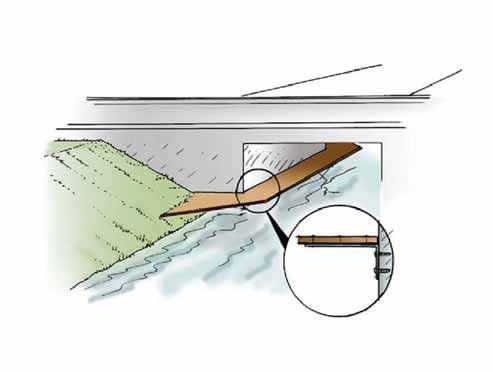
Figure 54. Schematic. Modified culvert (Reprinted with permission from Kruidering et al.2005).
USE OF THE STRUCTURE
Movement of water and wildlife
GENERAL GUIDELINES
- Adapting drainages and canals for wildlife use is a cost-effective means to provide wildlife passage associated with wetlands and other habitats that are inundated year-round or seasonally.
- There is generally little human activity in these areas; nonetheless, to ensure performance and function a modified culvert should have minimal human disturbance.
- Little modifications are needed to adapt canal bridges for wildlife passage. Platforms made of sturdy materials (corrugated metal is not recommended) such as galvanized steel, concrete or wooden boards ("2 x 10s") work well. It is important to keep the walkway platforms dry, above the high-water mark and accessible from adjacent dry habitat.
- Any work to adapt a bridge structure for wildlife passage should not impede or reduce the bridges hydrologic capacity or function.
DIMENSIONS - GENERAL GUIDELINES
- The dimensions of bridges for carrying water are a function of the hydrologic condition and needs of the area.
- Design and dimensions of walkways for wildlife will vary depending on the target species.
- Walkways: Recommended minimum > 1.5 ft (0.5 m) wide.
- Access ramps: Recommended <30 degrees slope.
TYPES OF CONSTRUCTION
- Concrete bottomless arch
- Prefabricated concrete box culvert
- Circular multi-plate metal culvert (these are least recommended, but can be adapted for wildlife passage using pre-fabricated metal shelves with service ramps (see Foresman 2003).
SUGGESTED DESIGN DETAILS
Crossing structure
- Structures should be designed to meet the movement needs of widest range of riparian- associated species that live in the area or might be expected to recolonize area.
- Wildlife walkways should run along both sides of the canal bridge. Walkways can be placed on only one side of the bridge interior in situations where wildlife habitat was primarily on one side of the bridge.
Local habitat management
- Attempt to provide continuous habitat leading to an adjacent to the structure. Re- vegetation of area may be needed after construction to restore habitat conditions.
- Encourage use of structure by using fencing, rock walls, or other barriers along road to direct wildlife into the modified culvert. Use topography and natural features as much as possible.
- If traffic volume is high on the road above the modified culvert it is recommended that sound attenuating walls be place above the entrance to reduce noise and light disturbance from passing vehicles.
POSSIBLE VARIATIONS
- Concrete platforms or walkways as an integral part of canal bridge structure.
- Platforms made of 2 in x 10 in wooden boards anchored to the interior wall of the structure.
- Pre-fabricated galvanized steel or metal shelves with service ramps installed in existing drainage culverts and bridges.
MAINTENANCE
- Periodic visits should be made to ensure that there is proper access, there are no material defects, or any obstacles in or near the underpass that might affect wildlife use. Checks should be made regularly but also after heavy rain events.
- Fences or other materials used to guide wildlife to the crossing should be checked, maintained and repaired periodically.
SPECIES-SPECIFIC GUIDELINES
Recommended/Optimum solution for wildlife species/groups
Carnivores
- Fisher, Marten, Weasel sp. - Species adaptable in habitat use and associated with a mix of habitat types, including riparian habitats (especially Fisher). Use of modified culverts is likely if located in or near riparian habitats where they reside.
Low mobility medium-sized mammals
- To encourage use from these species, structures should be placed in or near habitats where they are found.
Semi-aquatic mammals
- Mink, River Otter, Muskrats and other riparian-associated species are ideal species for use of a modified culvert, particularly if situated in or near riparian habitat.
Small mammals - (same as above for Low mobility medium-sized mammals)
Amphibians
- Efforts should be made to site underpass structure in known routes of seasonal migration, dispersal or other movement events for the target species. Not likely to use structure unless located in migratory route or in general area where dispersal may occur.
Reptiles - (same as above for Low mobility medium-sized mammals)
Possible if adapted
Carnivores
- Coyote, Fox1, Bobcat - Species adapted to range of habitat types, including riparian and wetlands. Modified culverts should be designed to provide for wide walkways for these species when located in or near habitats they are found.
- Fox2 - Species adapted to arid, open and agricultural habitats, occasionally with irrigation canals. Few documented cases of Swift/Kit Foxes using a range of wildlife crossing sizes, but generally avoid them preferring to cross at grade-level. Artificial dens should be installed near entrances to provide escape cover for Swift/Kit Foxes.
Not recommended or applicable
Ungulates
- Moose, Elk, Deer, Pronghorn, Bighorn Sheep, Mountain Goat
Carnivores
- Black Bear, Grizzly Bear, Wolf, Cougar, Lynx, Wolverine, Badger
Semi-arboreal mammals - all species.
Unknown - more data are required
None
HOT SHEET 11: AMPHIBIAN/REPTILE TUNNEL
GENERAL DESIGN
Crossing designed specifically for passage by amphibians, although other small- and medium- sized vertebrates may use as well. One of these is shown in Figure 55. There are many different amphibian/reptile tunnel designs to meet the specific requirements of each species or taxonomic group. Amphibian walls or drift fences are required to guide amphibians and reptiles to location of crossing structure.
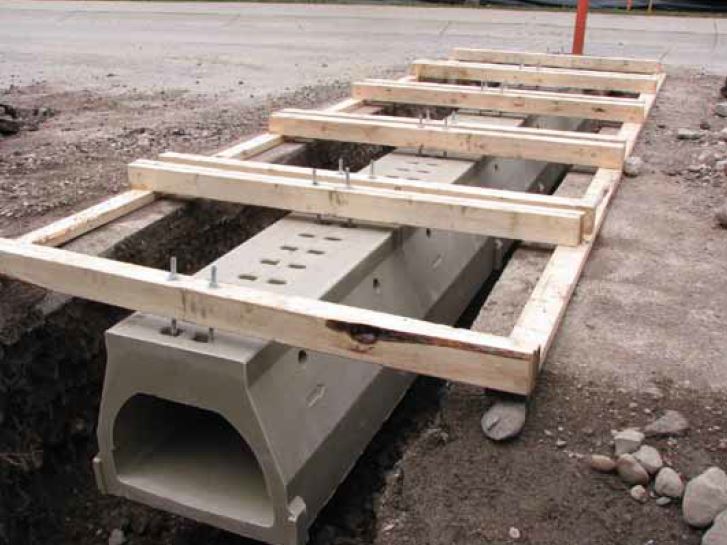
Figure 55. Photo. Construction and placement of amphibian tunnel in Waterton National Park, Alberta (Credit: Parks Canada).
USE OF THE STRUCTURE
Exclusively wildlife, primarily amphibians and reptiles
GENERAL GUIDELINES
- To ensure performance and function, amphibian/reptile tunnels should be situated in areas that are known amphibian migration routes and areas of reptile movements.
- Amphibians and reptiles have special requirements for wildlife crossing design since they are unable to orient their movements to locate tunnel entrances. Walls or fences play a critical function in intercepting amphibian and reptile movements and directing them to the crossing structure as Figure 56 shows.
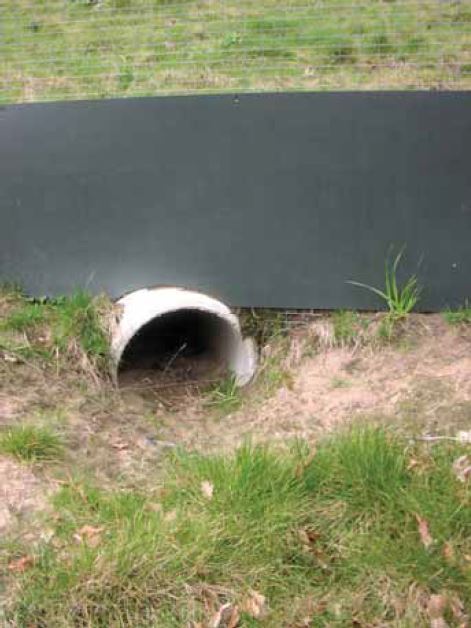
Figure 56. Photo. Drift fence for amphibians and reptiles (Credit: Tony Clevenger).
- Main conflicts with amphibians are where roads intercept periodic migration routes to breeding areas (ponds, lakes, streams or other aquatic habitats). For some species the migration to these critical areas, including the dispersal of juveniles to upland habitats, is synchronized each year. This large movement event results in a massive migration of individuals in a specific direction during a short period of time. Amphibian/reptile tunnels should be located in these key sections of road that intercept their movements year after year. Without tunnels to provide safe passage over the road, huge concentrations of amphibians are run over by vehicles, in some cases causing dangerous driving conditions similar to "black ice."
- Large tunnels provide greater airflow and natural light conditions; however, smaller tunnels with grated slots for ambient light and moisture can be effective as Figure 57 shows. Grated tunnels are placed flush with the road surface. Distance between tunnels should be 150 ft (45 m) or less.
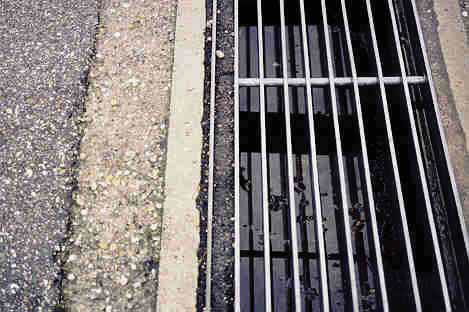
Figure 57. Photo. Grated slots on amphibian tunnels allows light and conservers ambient temperatures and humidity (Credit: Anonymous).
- Maximize continuity of native soils adjacent to and within the tunnel, if possible. Avoid importation of soils from outside project area.
- Tunnel should be designed to conform to local topography. Design drainage features' so flooding does not occur within amphibian/reptile tunnels. Run-off from highway near structure should not end up in tunnel.
DIMENSIONS - GENERAL GUIDELINES
- The width of amphibian/reptile tunnel will increase with tunnel length.
- The following recommended dimensions were adapted from Ministerio de Medio Ambiente (2006), Kruidering et al. (2005) and Jackson (2003).
| Construction design |
Tunnel length (ft) |
| |
<65 |
65-100 |
100-130 |
130-165 |
165-200 |
| Rectangular |
3.2 x 2.5 |
5.0 x 3.2 |
5.75 x 4.0 |
6.5 x 5.0 |
7.5 x 5.75 |
| Circular (diameter) |
3.2 |
4.5 |
5.25 |
6.5 |
8.0 |
- Maximum distance between tunnels: 150 ft (45 m), but a 200 ft (60 m) distance could be used if guiding walls/fences are funnel-shaped to guide amphibians to tunnel.
- Minimum height of guiding wall/fence: 1.25 ft (0.4 m); 2.0 ft (0.6 m) for some jumping species.
TYPES OF CONSTRUCTION
- Rectangular and square/box (prefabricated concrete). This design is preferred because vertical walls facilitate movement of amphibians and reptiles through tunnel.
- Circular (prefabricated concrete, metal corrugated, steel, PVC piping, polymer surface product). Steel is not desirable because of its high conductivity and coldness during spring migratory periods.
- Open grated tunnels allow for more natural light and conditions of humidity inside tunnels.
SUGGESTED DESIGN DETAILS
Crossing structure
- Requirements for tunnel design and microhabitat differ among amphibian taxa (see Lesbarrères et al. 2003). Hesitancy and repeated unsuccessful entry attempts at tunnels is believed due to changes in microclimatic conditions, particularly temperature, light and humidity, that animals perceive as localized climate degradation. Larger tunnels (ca. 3 ft diameter) permit greater airflow and increased natural light at tunnel exits. Smaller tunnels can be effective if they are open-grated on top, increasing natural light and moisture. Sandy soil (sandy loam) should be used to cover the bottom of the tunnel to provide a more natural substrate for travel.
- Amphibians have been documented using tunnels that range in length from 22 ft (6.7 m) (Spotted salamanders, Massachusetts) to 125 ft (40 m) (Lausanne, Switzerland). The effectiveness of long tunnels spanning four-lane highways has not been tested.
- Tunnels should be situated at the base of the slope coming off the road grade. The shorter the length of tunnel the better for amphibian and reptile movement.
- Tunnels should be completely level, without slope of any kind at the entrances or within the tunnel.
- On divided highways, tunnels should be continuous, below-grade and not open up in the central median.
- Tunnels should have good drainage to avoid the flooding found in Figure 58. Amphibians are associated with mesic microhabitats but do not move through flooded tunnels.
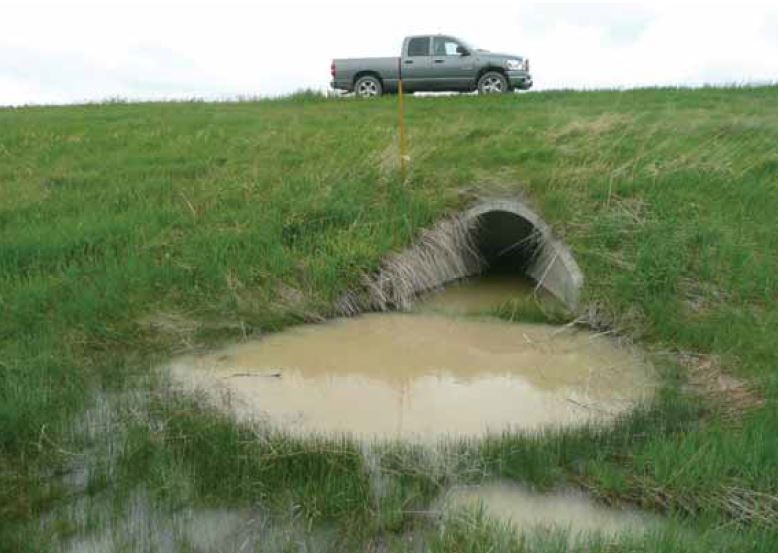
Figure 58. Photo. Flooding in front of tunnel due to improper drainage design (Credit: Tony Clevenger).
Guiding wall/fence
- Wing walls should angle out from each end of the tunnel at approximately 45 degrees.
- Guiding wall/fence will be 1.25 ft (0.4 m) high and made of concrete, treated wood or other opaque material. Guiding walls/fences made of translucent material or wire mesh are not recommended because some amphibians try to climb over them instead of moving towards the tunnel.
- Bottom section of guiding wall/fence will be secured to ground, not leaving any gaps. Guiding wall/fence will tie into the tunnel entrance, avoiding any surface irregularities that might impede or distract movement towards the tunnel entrance. Any small gaps or defects at the base of the guiding wall will lead to individuals getting onto the road and reducing the efficacy and performance of the tunnel.
- Vertical walls/fences are preferred as bowed or curved walls are more difficult to mow grass and can obstruct the travel of some amphibians moving towards tunnel.
- Walls/fencing should extend out from the tunnel and flare out away from the road at terminal points to orient animals that move away from the tunnel towards natural environment.
- In Waterton National Park, Alberta, curbs were modified into ramps to allow Long-toed Salamanders to cross a road during their annual migration as Figure 59 shows. Without the ramp, salamanders were blocked at the curb and run-over by vehicles.
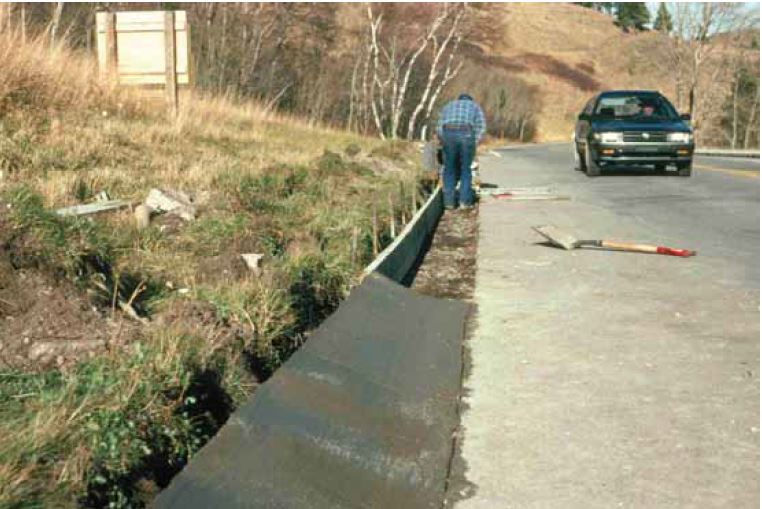
Figure 59. Photo. Construction of amphibian ramp to replace curb and allow cross-road movement of long-toed salamanders (Credit: Parks Canada).
Local habitat management
- Attempt to provide continuous habitat or vegetative cover leading to an adjacent to the structure. Re-vegetation of area may be needed after construction to restore habitat conditions and provide important cover during migrations and other movement events.
- If an open-grated tunnel, adapt substrate of tunnel to soil conditions and type located adjacent to tunnel.
POSSIBLE VARIATIONS
- Some experts suggest that natural light entering the tunnel from above will facilitate use by amphibians, thus recommending that a grill-type or grated cover be placed on tunnels shown earlier in Figure 57. There are no conclusive studies that demonstrate grates have a positive effect on movements of amphibians and reptiles.
Drift fences and translocations
- Due to the seasonality of amphibian movements across roads an option to a wildlife crossing structure consists of installing temporary system of amphibian protection that prevents animals from reaching the roadway. The system consists of constructing a temporary barrier or drift fence, made of a smooth and opaque fabric, staked down, for a predetermined length that impedes the movement of the majority of migrating amphibians towards the road as Figure 60 shows. The drift fence directs the amphibian to collection buckets where they are protected before being picked up and transported across the road. These systems are labor intensive and require collaboration from many people, usually agency and non-governmental organizations. Without citizen support these relatively inexpensive mitigation measures would usually not be possible.
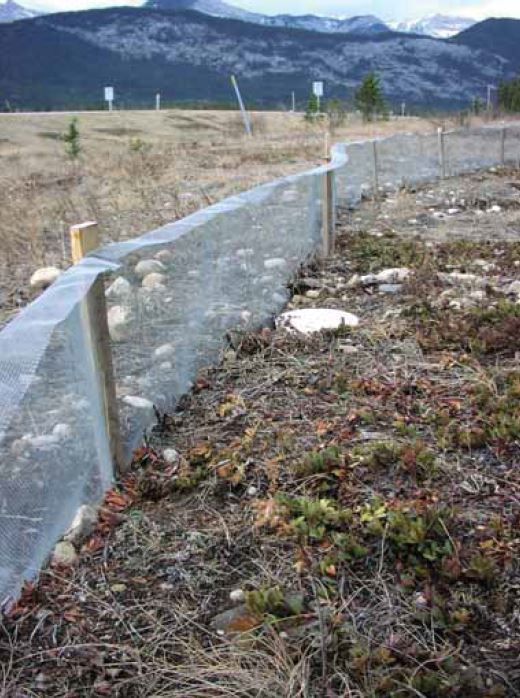
Figure 60. Photo. Barrier or drift fence for amphibians and reptiles (Credit: Tony Clevenger).
- Drift fence material must be entirely opaque, of smooth fabric (rigid plastic, polythene, canvas) and a minimum height of 1.25 ft (0.3 m) to keep amphibians and reptiles from climbing or jumping over. Stakes should be placed on the road-side of the drift fence and not the opposite, which would obstruct amphibian movement. If target species is a burrower, such as a Mole Salamanders, steps should be taken to prevent animals from burrowing under the fence. Burying the bottom 2 - 4 in (5 - 10 cm) should discourage burrowing under the fence. To prevent breaching by climbing amphibians and reptiles, fence designs that curve inwards or create an overhang or lip have been used successfully. Overhanging vegetation close to the fence has resulted in animals climbing over the fence onto the road. Fencing should be clear of obstructions and vegetation.
- Collection buckets should be placed right up against the drift fence to maximize the "capture" of migrating amphibians into the buckets as documented in Figure 61. Buckets should be a minimum depth of 12 - 16 in (30 - 40 cm), buried, with tops of buckets at ground level. The distance between collection buckets should be approximately 30 ft (9 m) apart. A bucket at each end of the drift fence will keep amphibians from reaching the roadway.
- During the migration periods, buckets are checked, amphibians collected and transported across the road every 8 to 24 hours. The interval between checks will depend on the intensity of the movement event. During mass movements or migrations, buckets may need to be checked on an hourly basis.
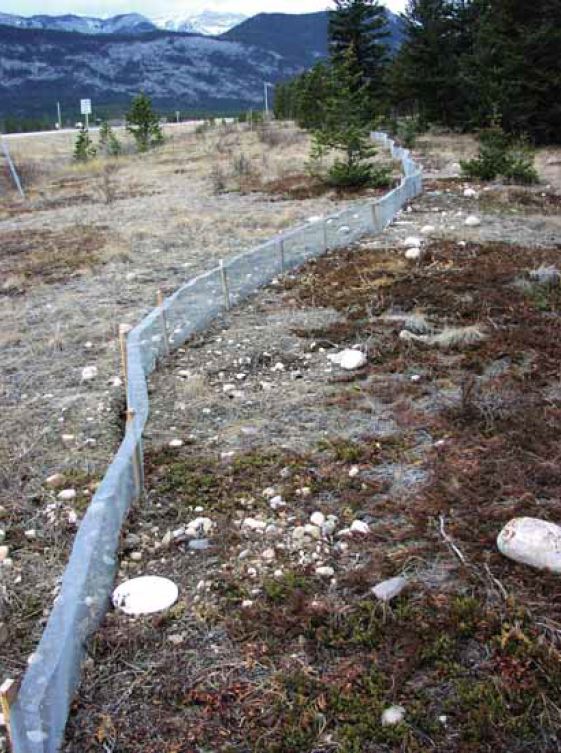
Figure 61. Photo. Drift fence and collection buckets (Credit: Tony Clevenger).
MAINTENANCE
- Periodic visits should be made to ensure that there is proper access, there are no material defects, or any obstacles in or near the tunnel that might affect amphibian use. Checks should be made regularly but also after heavy rain events.
- Guiding walls/fences or other materials used to guide wildlife to the crossing should be checked, maintained and repaired periodically.
- Grass should be mowed within 2 ft (0.6 m) of the guiding wall/fence on the side that amphibians will travel. This task is important during the migratory period, which will vary among species and environmental conditions. Herpetologists or local naturalists will be able to recommend the best time for mowing for each particular situation.
SPECIES-SPECIFIC GUIDELINES
Recommended/Optimum solution for wildlife species/groups
Amphibians
- Ideal crossing structure for this taxa. Requirements for tunnel design and microhabitat differ among amphibian taxa. Design of tunnel should meet the requirements of target species. Efforts should be made to site tunnel in known routes of seasonal migration, dispersal or other movement events for the target species. Not likely to use structure unless located in migratory route, within preferred habitat or in general area where dispersal events may occur.
Reptiles
- Ideal crossing structure for this taxa. Requirements for tunnel design and microhabitat differ among reptile taxa. Design of tunnel should meet the requirements of target species. Efforts should be made to site tunnel in known routes of seasonal movements, dispersal or other movement events for the target species. Not likely to use structure unless located in movement area, within preferred habitat or in general area where dispersal events may occur.
Possible if adapted
Low mobility medium-sized mammals
- To encourage use from these species, structures should be placed in or near habitats where they are found. Placement of cover near entrances and leading to adjacent habitat will increase the likelihood of use. If the tunnel is large, cover placed along inside walls will encourage use by these species.
Semi-aquatic mammals
- Their association with wetlands and aquatic habitat components will increase probability of tunnel use by these species, if located in or near habitats where they reside. Placement of adequate cover near entrances and leading to adjacent habitat will increase the likelihood of use by these species.
Small mammals - (same as above for Low mobility medium-sized mammals)
Not recommended or applicable
Ungulates - all species.
Carnivores - all species.
Semi-arboreal mammals - all species.
Unknown - more data are required
None
HOT SHEET 12: FENCING - LARGE MAMMALS
GENERAL PURPOSE
Wildlife exclusion fencing keeps animals away from roadways. However, fencing alone can isolate wildlife populations, thus creating a barrier to movement, interchange and limiting access to important resources for individuals and long-term survival of the population. Fencing like that in Figure 62, is one part of a two-part mitigation strategy - fencing and wildlife crossing structures. Fences keep wildlife away from the roadway, lead animals to wildlife crossings, thus allowing them to travel safely under or above the highway. Fences need to be impermeable to wildlife movement in order to keep traffic-related mortality to a minimum and ensure that wildlife crossings may be used. Defective or permeable fences result in reduced use of the wildlife crossings and increased risk of wildlife - vehicle collisions. Little research and best management practices exist regarding effective fence designs and other innovative solutions to keep wildlife away from roads.
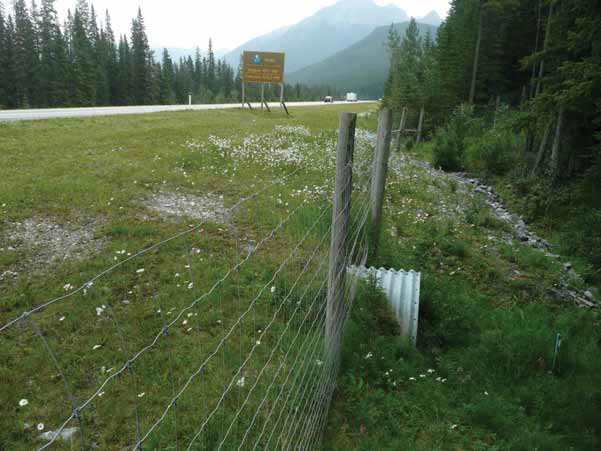
Figure 62. Photo. Wildlife exclusion fencing and culvert design wildlife underpass (Credit: Tony Clevenger).
CONFIGURATIONS
Fencing configuration used to mitigate road impacts will depend on several variables associated with the specific location, primarily adjacent land use and traffic volumes. Both sides of the road must be fenced (not only one side) and fence ends across the road needs to be symmetric and not offset or staggered.
Continuous fencing
Most often associated with large tracts of public land with little or no interspersed private property or in-holdings.
Advantages: Long stretches of continuous fence have fewer fence ends and generally few problems of managing wildlife movement ("end-runs") around multiple fence ends, as with discontinuous fencing (below).
Disadvantages: Access roads with continuous fencing will need cattle guards (see Hot Sheet 14) or gates to block animal access to roads.
Partial (discontinuous) fencing
More common with highway mitigation for wildlife in rural areas characterized by mixed land use (public and private land). Generally installed when private lands cannot be fenced.
Advantages: Generally accepted by public stakeholders. Few benefits to wildlife and usually the only alternative when there is mixed land use.
Disadvantages: Results in multiple segments of fenced and unfenced sections of road, each fenced section having two fence ends. Additional measures need to be installed and carefully monitored to discourage end-runs at fence ends and hasten wildlife use of new crossing structures (see Terminations below).
INTERCEPTIONS
Fences invariably intersect other linear features that allow for movement of people or transport materials. This can include access roads, but also people (recreations trails) and water (creeks, streams). These breaks or interceptions in the fence require special modifications in order to limit the number of wildlife intrusions to the right-of-way.
Roads
- Cattle guards - Transportation and land management agencies commonly install cattle guards ("Texas gates" in Canada) shown by Figure 63, where fences intersect access roads. Many different designs have been used, but few if any have been tested. Designs of cattle guards vary in dimension, grate material (flat or cylindrical steel grates), and grate adaptations for safe passage by pedestrians and cyclists. Recently a grate pattern was developed that was 95% effective in blocking Key deer movement and was safe for pedestrians and cyclists (Peterson et al. 2003). A cattle guard roughly 6-8 ft (1.8-2.4 m) long and covering 2 lanes of traffic costs approximately $40,000 (Terry McGuire, Parks Canada, personal communication).
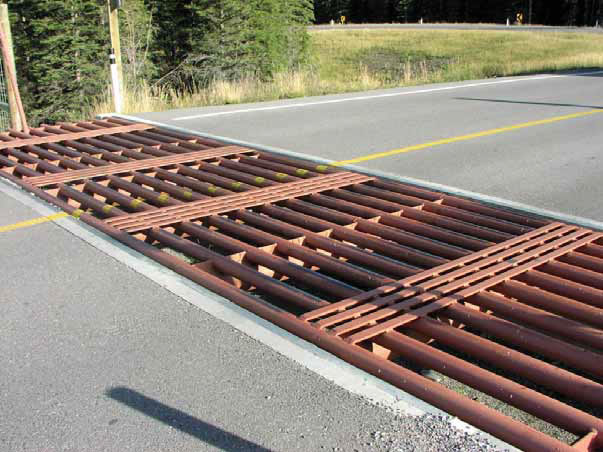
Figure 63. Photo. Cattle guard (Texas gate) in road (Credit: Tony Clevenger).
- Electric cattle guards - These electrified mats act like electric cattle guards to discourage wildlife from crossing the gap in the fence. Pedestrians wearing shoes and bicyclists can cross the mats safely, but dogs, horses and people without shoes will receive an electric shock. The electro-mats are generally 4 feet (1.2 m) wide and built into access roads where they breach fences. ElectroBraid™ and GapZapper® are two companies that currently design and sell electric cattle guards.
- Painted crosswalks - Highway crosswalk structures have been used to negotiate ungulates across highways at grade level (Lenhert and Bissonette 1997). White crosswalk lines are painted across the road to emulate a cattle guard. The painted crosswalk serves as a visual cue to guide ungulates directly across the highway. Painted crosswalks have not been tested, but if effective, they would be an inexpensive alternative to the more costly cattle guards.
Trails
- Swing gates (fisherman, hikers) - Where fences impede public access to popular recreation areas, swing gates can be used to negotiate fences. Gates must have a spring- activated hinge that ensures that even if the gate is left open it will spring back and close. In areas of high snowfall, gates may be elevated and steps built to keep the bottom of the gate above snow as Figure 64 shows.
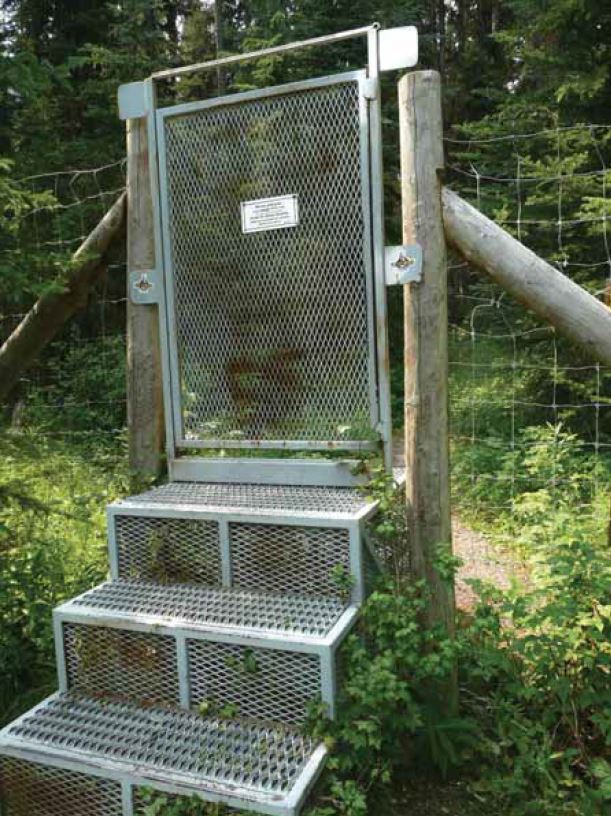
Figure 64. Photo. Step gate with spring-loaded door situated at trailhead in Banff National Park, Alberta (Credit: Tony Clevenger).
- Canoe/Kayak landings - There are no known simple gate solutions for transporting canoes/kayaks through fences. Swing gate described above is one solution, although the gate should be slightly wider than normal to allow wide berth while moving canoe/kayaks. Gates must have a spring-activated hinge that ensures they remain closed after use.
Watercourses
- Rubber hanging drapes - Watercourses pose problems for keeping fences impermeable to wildlife movement, as their flow levels tend to fluctuate throughout the year. When water levels are low, gaps may appear under the fence material allowing wildlife to easily pass beneath. Having fencing material well within watercourses will cause flooding problems, as debris being transported will not pass through the fence and can eventually obstruct water flow.
- A solution to this problem would require having a device on the bottom of the fence that moves up and down with the water levels. This could be done by attaching hinged strips of rubber mat-like material, draping down from the bottom of the fence material into the water. The rubber strips are hinged, so float on top of the water and move in direction of flow.
SUGGESTED DESIGN DETAILS
Mesh type, gauge & size
Fence material may consist of woven-wire (page-wire) or galvanized chain-link fencing. Fence material must be attached to the back-side (non-highway) of the posts, so impacts will only take down the fence material and not the fence posts.
- Woven- or page-wire fencing - Woven wire fences consist of smooth horizontal (line) wires held apart by vertical (stay) wires. Spacing between line wires may vary from 3 in (8 cm) at the bottom for small animals to 6-7 in (15-18 cm) at the top for large animals. Wire spacing generally increases with fence height. Mesh wire is made in 11, 12, 12 ½, 14, and 16 gauges and fences are available in different mesh and knot designs. The square-shaped mesh may facilitate climbing by some wildlife, such as bears. If climbing is a concern then use of a smaller mesh is recommended. Higher gauge wire mesh is more durable and will last longer than smaller gauge mesh. Wildlife fences along the Trans- Canada Highway in Banff National Park consisted of line wires with tensile strength of 1390 N/sq. mm and 12 ½ gauge. Stay wires had tensile strength of 850 N/sq. mm. All wires were Class 111 zinc galvanized coating at a minimum of 260 gms/sq. m.
- Chain-link fencing - Chain-link fence is made of heavy steel wire woven to form a diamond-shaped mesh. They can be made into fences and used in various applications, primarily industrial, commercial and residential. Chain-link was used for highway mitigation fencing along I-75 and SR 29 in Florida. There have been agency and public concerns about the visual aesthetics of chain-link fencing compared to woven-wire as it is less attractive and does not blend into the landscape. Steel posts are always used with chain-link fencing. Chain-link fence fabrics can be galvanized mesh, plastic coated galvanized mesh or aluminum mesh.
- Most wire sold today for fencing has a coating to protect the wire from rust and corrosion. Galvanizing is the most common protective coating. The degree of protection depends on thickness of galvanizing and is classified into three categories; Classes I, II, and III. Class I has the thinnest coating and the shortest life expectancy. Nine-gage wire with Class I coating will start showing general rusting in 8 to 10 years, while the same wire with Class III coating will show rust in 15 to 20 years.
- Electrified fencing - Electric fences are a safe and effective means to deter large wildlife from entering highway right-of-ways, airfields and croplands. The 7 ft (2 m) high fence will deliver a mild electric shock to animals that touch it, discouraging them from passing through. It is made of several horizontal strands of rope-like material about a ½ in (1 cm) in diameter that can deliver a quick shock that is enough to sting, but not seriously harm humans. Wildlife respond differently to standard electric fences; high voltage fences are generally required to keep bears away. There are public safety issues of having electrified fencing bordering public roads and highways as there is high likelihood that people will come into contact with the fence (fishermen, hikers, motorists that run into fence).
Post types
- Wood - Wood posts are commonly used and can be less expensive than other materials if cut from the farm woodlot or if untreated posts are purchased. Post durability varies with species. For example, osage orange and black locust posts have a lifespan of 20 to 25 years whereas southern pine and yellow-poplar rot in a few years if untreated.
- The life expectancy of pressure-treated wooden posts is generally 20 - 30 years depending on the type of wood. Softwoods are the most common wood used for posts when fencing highways. Lodgepole pine and Jack pine are common tree species for fence posts. For Trans-Canada Highway wildlife fences all round fence posts were pressure treated with a chromate copper arsenate (CCA) wood preservative.
- Wood posts are highly variable in size and shape. For typical 2.4 m high fencing 12 ft (3.7 m) and 13.7 ft (4.2 m) long, non-sharpened wooden posts are supplied. Fence posts are sharpened and then installed by preparing a pilot hole approximately 5 in. (125 mm) in diameter, vibrating the post down to specified post height and backfilling with a compacted non-organic material around post to level of existing ground. Strength of wood posts increases with top diameter. Post strength is especially important for corner and gate posts, which should have a top diameter of at least 6.5 in (16 cm). Line posts can be as small as 5 in (13 cm) and should not need to be more than 6.5 in on top diameter, although larger diameter posts make fences stronger and more durable.
- Steel - Steel posts are used to support fences when crossing rock substrate. They weigh less and last longer than wood posts; the main disadvantage is they are more expensive than wood posts. Steel posts are supplied in 12 ft (3.7 m) lengths and installed in concreted 3.2 ft (1000 mm) long sleeves for the 12 ft x 3 in. steel posts.
- Tension - Tension between posts can consist of metal tubing on metal posts and reinforced cable on wooden posts.
REINFORCEMENTS
Unburied fence
Unburied fences are used in areas where resident wildlife are not likely to dig under the fence. The fence material should be flush with the ground to minimize animals crawling beneath the fence and reaching the right-of-way.
Buried fence
Strongly recommended in areas with wildlife capable of digging under the fence (e.g., bears, canids, badgers, wild boar). As illustrated in Figure 65, buried fence in Banff National Park significantly reduced wildlife intrusions to the right-of-way compared to unburied fence (Clevenger et al. 2002). Buried fence consist of a 4-5 ft (1-1.2 m) wide section of galvanized chain-link fence spliced to the bottom of unburied fence material. The chain-link section is buried at a 45-degree angle away from the highway and is approximately 3.5 ft (1.1 m) below ground. Swing gates should have a concrete base to discourage digging under them as shown in Figure 66.
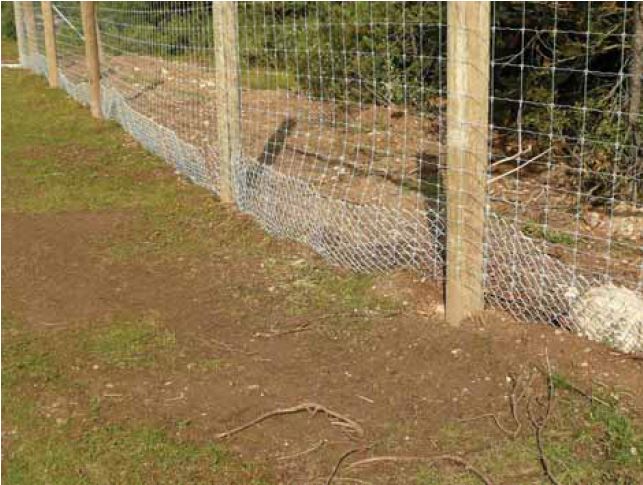
Figure 65. Photo. Wildlife exclusion fence with buried apron (Credit: Tony Clevenger).
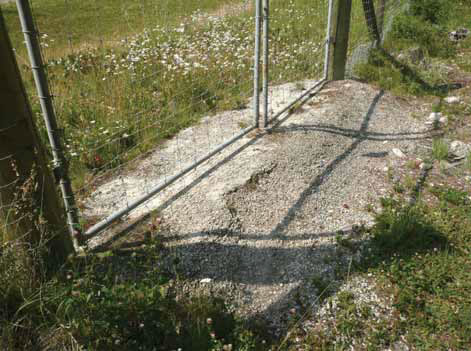
Figure 66. Photo. Concrete base of swing gate to prevent animal digging under wildlife fence (Credit: Tony Clevenger).
Cable (protective)
Trees blown onto fences can not only damage fence material but provide openings for wildlife to enter the right-of-way. Typically a problem the inital years after construction, but can continue over time. A high-tensile cable shown in Figure 67 strung on top of fence posts to help break the fall of trees onto the fence material should reduce fence damage, repair costs and maintenance time.
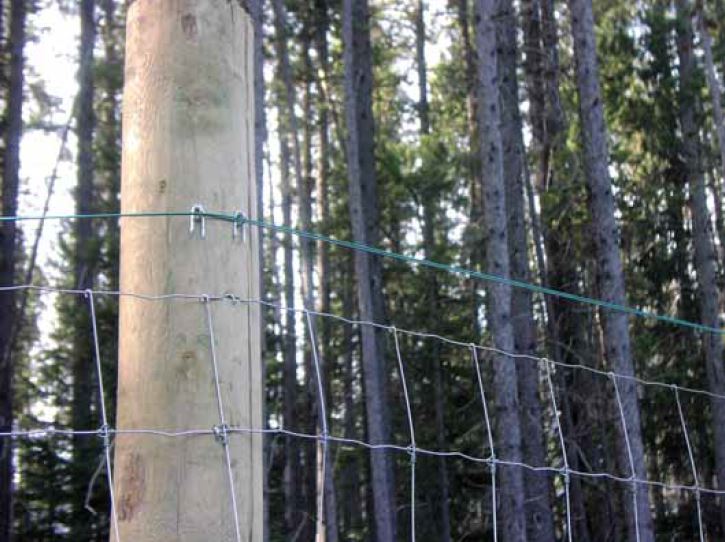
Figure 67. Photo. High tensile cable designed to break fall of trees onto fence material (Credit: Tony Clevenger).
TERMINATIONS
Fence ends are notorious locations for wildlife movements across roads and accidents with wildlife. The problem is more acute soon after fence installation as wildlife are confused, unsure where to cross the road, and tend to follow fences to their termination, and then make end-runs across the road or graze inside the fence.
Each mitigation situation is different and will require a site-specific assessment, but as a general rule, fence ends should terminate at a wildlife crossing structure. If a wildlife crossing cannot be installed at the fence ends, then fences should be designed to terminate in the least suitable location or habitat for wildlife movement - i.e., places wildlife are least likely to cross roads.
Some examples are:
- Steep, rugged terrain such as rock-cuts (Bighorn Sheep and Mountain Goats excluded).
- Habitats that tend to limit movement, e.g., open areas for forest-dwelling species.
- Areas with regular human activity and disturbance.
Another consideration is motorist visibility and speed at fence ends. Fences should end on straight sections of highway with good motorist visibility. Lighting at fence ends may improve motorist visibility and actually enhance road crossings by ungulate species; however, it may deter movement by wary carnivore species. Regardless of the situation, proper signage as Figure 68 shows must be installed to warn motorists of potential wildlife activity and crossings at fence ends.
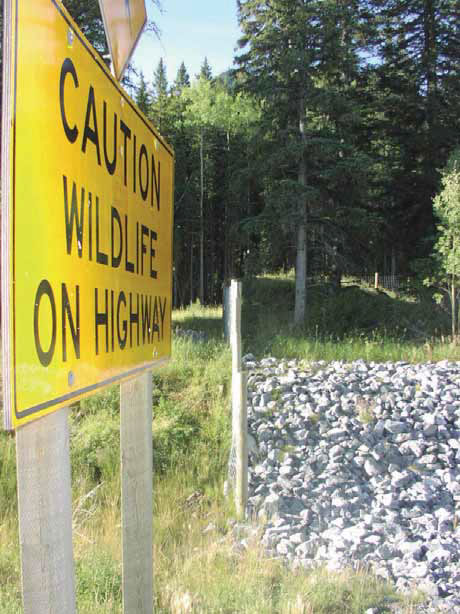
Figure 68. Photo. Warning signage at end of wildlife exclusion fence (Credit: Tony Clevenger).
Because fence ends create a hazardous situation for motorist and wildlife, it is important to discourage wildlife movement towards fence ends. Having wildlife locate and use wildlife crossings as soon as possible after construction is the best recommendation to discourage end- runs. Cutting trails to wildlife crossings, baiting or use of attractants should help direct wildlife to crossings and hasten the adaptation process.
DIMENSIONS - GENERAL GUIDELINES
Highway fencing for large mammals, including most native ungulate species of Moose, Elk, Deer, Bighorn Sheep, should be a minimum of 8.0 ft (2.4 m) high with post separation on average every 14-18 ft (4.2-5.4 m). In some cases the fence height may not need to be designed for large ungulates. Alternate fence design and specifications will need to consider not only fence requirements for species present, but also species that may potentially recolonize or disperse into the area in the future.
POSSIBLE VARIATIONS
Boulders/terrain
Boulders as a substitute for wildlife fencing has not proved to be effective; however, boulder fields or aprons have been used to effectively discourage wildlife entering the highway right-of- way at fence ends. The boulder apron is positioned on both road shoulders and at the ends of fence (and median for four-lane highway) and can range from 165-325 ft (50-100 m) long (along roadway). The shoulder aprons vary in width from about 25-65 ft (8-20 m), depending on how close the fence is positioned to the roadway - the boulders must extend right from the edge of pavement up to the fence to preclude any path for wildlife to skirt the boulders. Boulder aprons are made of subangular, quarried rock, ranging in size from 10-25 in (20-60 cm), however most should be larger than 12 in (30 cm). The boulder apron, at a depth of about 16-20 in (40-50 cm), is installed on geofabric on sub-excavated smoothed ground. The boulders project about 10-12 in (20-30 cm) above local ground surface as shown in Figure 69.
Reduced fence height
Lower than average fence height may be prescribed where there are commercial or residential concerns of visual effects and aesthetics of fencing. Reducing the fence height (e.g., 6 ft [1.8 m]) with respect to the adjacent area by running the fence through a lowered or depressed area will make the fence appear lower and less obtrusive. Planting shrubs and low trees in front of the fence will also help the fence blend into the landscape.
Outriggers/overhangs
Although never formally tested, outriggers or fence overhangs could potentially discourage wildlife (bears, cat species) from climbing fences and reaching the right-of-way.
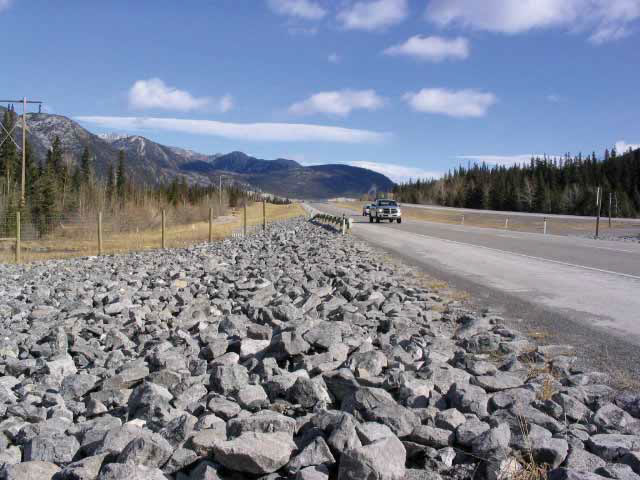
Figure 69. Photo. Boulder field at end of wildlife fence (Credit: Tony Clevenger).
Barbed wire overhangs
Similar to outriggers and fence overhangs, barbed wire overhangs are commonly used in urban areas to keep people out of areas. Overhangs of this type are found on Interstate-75 in Florida and have apparently been effective in keeping panthers and black bears from climbing the fence.
Gap below fence material for Pronghorn
The movement and migration of Pronghorn is affected by the network of fences they need to negotiate to meet their biological needs. Although not particular to wildlife fencing for wildlife crossing structures, it is worth noting that standard 4 ft (1.1 m) high road-side fencing, typically of barbed-wire, can be modified to improve Pronghorn movement. Pronghorn do not jump over fences, even 4 ft (1.1 m) fences, but generally try to crawl underneath. Transportation agencies have had success in getting Pronghorn to move through their preferred crossing areas by removing the bottom strand of barbed-wire.
MAINTENANCE
Fences are not permanent structures, neither are they indestructible. They are subject to constantly occurring damage from vehicular accidents, falling trees, and vandalism. Natural events also cause continually occurring damage and threaten the integrity of the fence: soil erosion, excavation by animals, and flooding can loosen fence posts and collapse portions of fence.
Fences must be checked every 6 months by walking entire fence line, identifying gaps, breaks and other defects caused by natural and non-natural events.
HOT SHEET 13: FENCING - SMALL AND MEDIUM VERTEBRATES
GENERAL PURPOSE
Most fencing for large mammals (see Hot Sheet 12) does not impede movement by small and medium sized mammals. These smaller mammals need a denser mesh fence material to keep them from entering the right-of-way. Fence design specifications for amphibians and reptiles are covered in Hot Sheet 11. Some small and medium-sized mammals are able to climb or dig under fence material, thus requiring a specific design in order to work effectively.
APPLICATION
- Generally recommended on sections of highway where high rates of mortality occur (or are predicted to occur) for one particular species.
- Designed to meet site- and species-specific needs of preventing animal movement through large mammal fences. Fencing should not be extensive, otherwise movements of non- target small mammals will be affected and populations will become isolated.
- Fencing for small and medium-sized mammals is joined to existing large mammal fencing (or installed simultaneously) and placed at ground level, shown in Figure 70. Fencing should be placed on the outside of the large mammal fence (non-highway side) and fastened to the large mammal fence material.
- Fencing for small and medium-sized mammals should always be used in conjunction with wildlife crossing structures designed for their specific use.
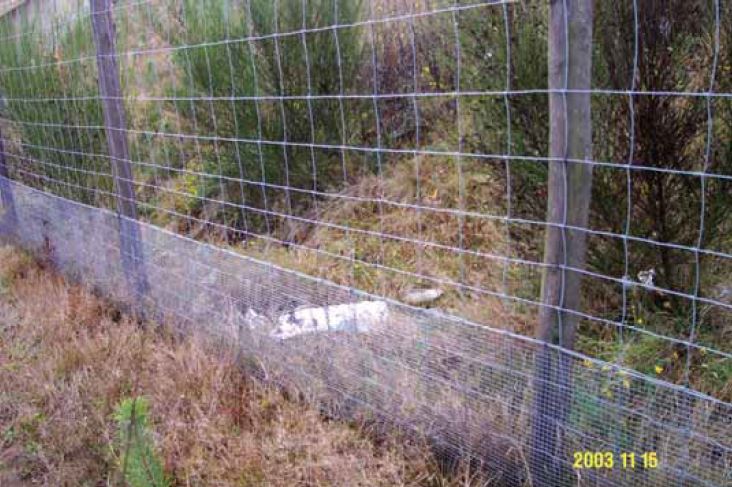
Figure 70. Photo. Small and medium-sized mammal fence material spliced to large mammal fence material (Credit: Nancy Newhouse).
SUGGESTED DESIGN DETAILS
Installation
- Fence material should be buried below ground 6-10 in (15-20 cm).
- Where fencing meets tunnels or other wildlife crossing structures it is advisable that fence material is well connected to the wing walls or sides of the structures, not allowing any gaps where they meet.
- Where fences meet drainage culverts they should either pass above or integrate the culvert into the fence.
Mesh types and sizes
- Fence material generally consists of hardware cloth or welded wire-mesh. The wire mesh comes in a variety of mesh sizes, colors and coatings to meet specific needs of each target species and objective.
- The standard mesh size is ½ in (1 cm), although larger mesh may be used for larger target species.
- The top 2-3 in (4-6 cm) of fence material should be doubled-back away from the highway at a 45-degree angle to discourage animals from climbing over the fence.
Dimensions
- The standard height of fencing is 2 ft (0.6 m) above the ground. This height can be adjusted depending on the target species and project objectives. For example, 16 in (40 cm) above the ground is sufficient for desert tortoises.
POSSIBLE VARIATIONS
For adept climbers (mink, weasels, martens ) fences should be constructed at least 4 ft (1.2 m) high, ½-1 in (1-2 cm) welded wire mesh. The top portion should be 6-10 in (15-25 cm) in length and doubled-back away from the large mammal fence material in outrigger fashion.
MAINTENANCE
- Fences are not permanent structures, neither are they indestructible. They are subject to constantly occurring damage from vehicular accidents, falling trees, and vandalism. Natural events also cause continually occurring damage and threaten the integrity of the fence: soil erosion, excavation by animals, and flooding can loosen fence posts and collapse portions of fence.
- Fences must be checked every 6 months by walking entire fence line, identifying gaps, breaks and other defects caused by natural and non-natural events.
HOT SHEET 14: GATES AND RAMPS
GENERAL PURPOSE
If wildlife become trapped inside the fenced area, they need to be able to safely exit the highway area. The most effective means of escape are through a steel swing gate, hinged metal door or earthen ramp (or "jump-out") as Figure 71 shows. A low cost way to provide escape is to lay natural objects (tree trunks or limbs) against the fence. The number, type and location of escape structures will depend on the target species, terrain and habitat adjacent to the highway fence.
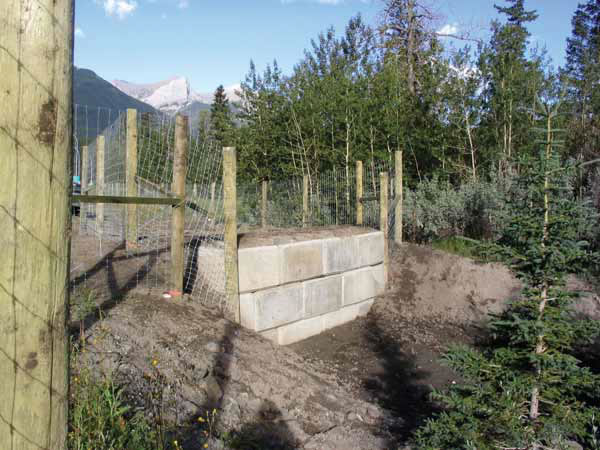
Figure 71. Photo. Escape ramp (jump-out) for wildlife trapped inside highway right-of- way (Credit: Tony Clevenger).
APPLICATION
Swing gates
Swing gates are generally used (with or without ramps) in areas where highways are regularly patrolled by wardens/rangers. As part of their job, if wildlife are found inside the fence, the nearest gates are opened and animals are moved towards the opened gate illustrated in Figure 72. Double swing gates are more effective than single swing gates, especially for larger mammals such as Elk or Moose. Swing gates are used to remove ungulates and large carnivores (e.g., bears) as smaller wildlife can escape by hinged doors at ground level (see below) or through large mammal fence material.
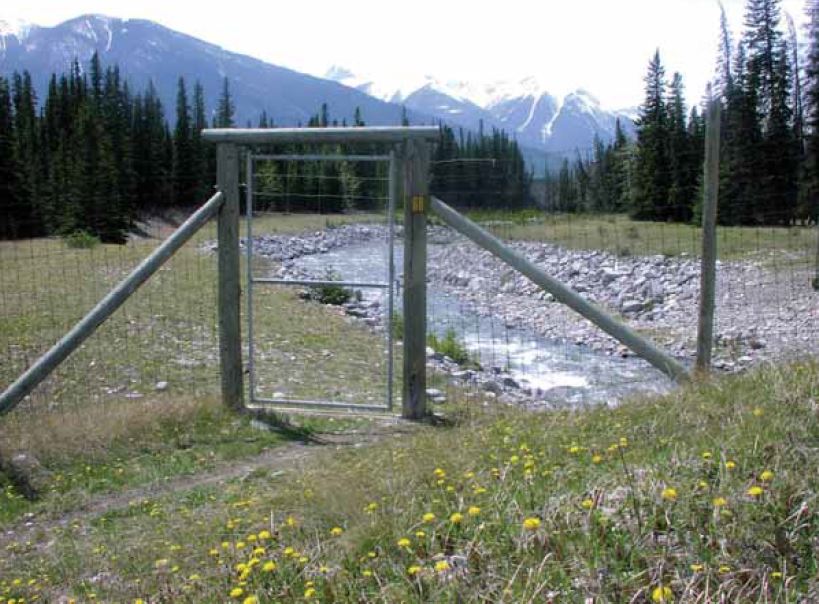
Figure 72. Photo. Single swing gate in wildlife exclusion fence (Credit: Tony Clevenger). Earthen ramps or jump-outs
Earthen ramps or jump-outs allow wildlife (large and small) to safely exit right-of-ways on their own without aid of wardens or rangers. Typically wildlife find the ramps and exit by jumping down to the opposite side of fence shown in Figure 73. Deer and Elk are the most common users, but Moose, Bighorn Sheep, Bears and Cougars use these structures as well. The outside walls of the escape ramp must be high enough to discourage wildlife from jumping up onto the ramp and access the right-of-way. However, the walls should not be so high they discourage wildlife from jumping off. The landing spot around the outside wall must consist of loose soil or other soft material to prevent injury to animals. The outside walls must be smooth to prevent Bears or other animals from climbing up. For best use, escape ramps should be positioned in a set-back in the fence, in an area protected with dense vegetative cover, so animals can calm down and look over the situation before deciding to use the jump out or continue walking along the fence. A right-angle jog in the fence is recommended for positioning the escape ramp but not necessary.
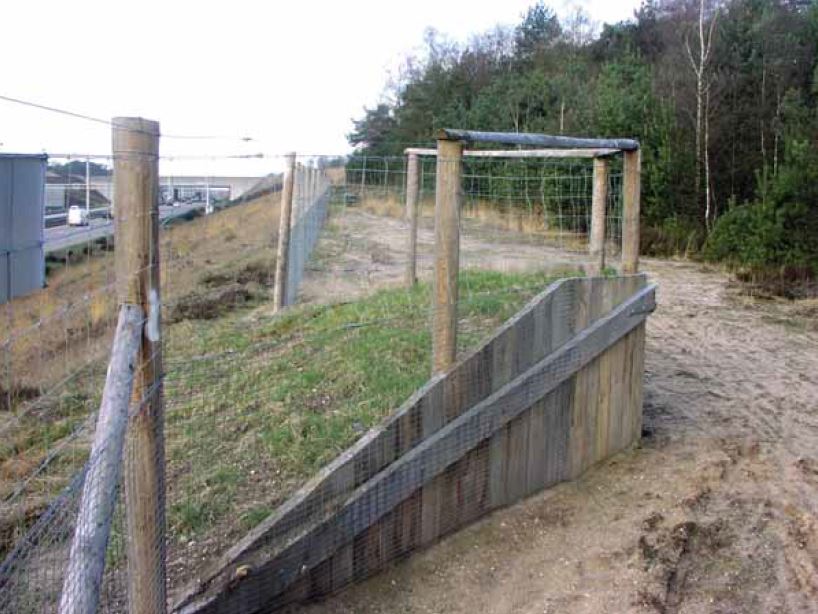
Figure 73. Photo. Wildlife escape ramp (jump-out; Credit: Tony Clevenger).
Small hinged doors
For small- and medium-sized mammals, natural objects (for climbing species) or small, hinged doors at ground level as shown in Figure 74 allow them to escape the right-of-way on their own.
Natural objects
Natural objects can be used simply, and cost-effectively to help small and medium-sized mammals exit the right-of-way. Stacking of brush and woody debris against the fence line and to fence height will allow climbers to exit safely.
Like fences, escape structures need to be carefully planned for the wildlife they are targeted, their location, design and maintenance over time.
MAINTENANCE
Like fences, gates and ramps are not permanent structures, neither are they indestructible. They are subject to constantly occurring damage from vehicular accidents, falling trees, and vandalism. Natural events also can cause damage, obstruct gates and affect how well they perform.
Like fences, escape structures must be checked every six months to ensure that they are functioning properly and perform when needed. Maintenance checks should take place at the same time as fence inspections (see Hot Sheets 12 and 13).
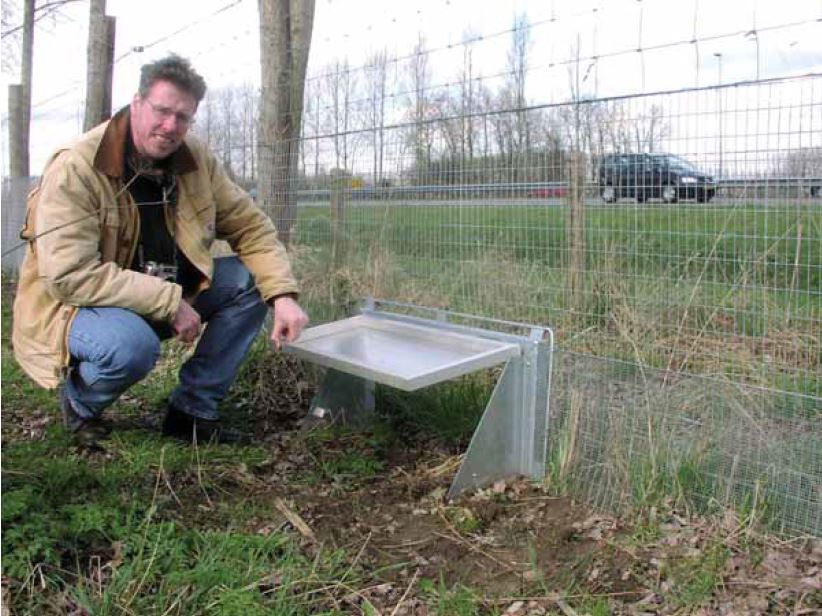
Figure 74. Photo. Hinged door for escape of medium-sized mammals (Credit: Tony Clevenger).
APPENDIX D - FRAMEWORK FOR MONITORING
Framework for evaluating the performance of measures designed to reduce wildlife - vehicle collisions and barrier effects of roads on wildlife movement. Numbers for monitoring questions relate to one another across columns. Black text = Monitoring generally associated with highway corridor; Blue text = Monitoring and research needed to answer management questions from the project area at the landscape scale.
| MONITORING OBJECTIVES |
Monitoring question |
Methods |
Study design |
Targets |
WILDLIFE - VEHICLE COLLISION REDUCTION
(PRE- AND POST- CONSTRUCTION) |
- Do crossing structures reduce mortality rates?
- Compared to baseline levels of road mortality;
- Compared to adjacent "control" areas post-construction;
- Compared to other sections of highway without crossing structures
- What is the incidence of mortality among a marked sample? [Addressing this question will require large sample sizes and representative sampling of population]
|
Road-kill data collection:
1 & 2. Road-kill surveys on highway sections with and without crossing structures. Surveys must be extensive in length (see Feldhamer et al. 1986) and systematically conducted at frequent intervals
Radiotelemetry:
3. Standard capture-mark-release techniques. Transmitters may consist of VHF transmitters or global positioning system (GPS) transmitters with the latter providing more spatial accuracy in identifying how and where animals cross highways. |
Road-kill data collection:
1.a. (1) Pre- vs post-construction comparison of mortality rates on "treatment" areas (crossing structures) with "controls" (BACI1 design)
- (2) Pre- vs post- construction comparison of mortality rates on "treatment" areas (crossing structures) and those without "controls (BA1 design)"
- Post-construction comparison of mortality rates using "treatment" (crossing structures) sections vs. adjacent sections without crossing structures (CI1 design)
- Multivariate logistic regression analysis
- Comparison of mortality rates on sections with and without crossing structures, standardized by highway length
Radiotelemetry:
3. Proportion of marked sample killed on highway compared to control sections |
1 & 2. Reduction in mortality rates compared with baseline conditions (i.e., without crossing structures).
Reductions should either be statistically significant or deemed biologically meaningful.
3. Significant (statistical or biological) proportion of the marked sample survives and reproduces in highway environment with crossing structures. |
| RESTORING MOVEMENTS IN PROJECT AREA |
1. What is the frequency of movement across highway with crossing structures and without? |
Telemetry (radio or GPS):
1.2.3.4. (See above)
Observational data:
3 & 4a. Remote cameras that detect and record animal activity in highway environment over 24-hr period. Remote digital 35mm or video cameras installed on preferably straight and level sections of highway. Some video cameras detect and record animal activity on sections up to 1.0 mile in length
3 & 4b. Trackpads on right-of- way (Hardy et al. 2007)
3 & 4c. Fluorescent dye marking. Method allows for follow-up "tracking" of small animal using ultraviolet light at night (McDonald and Cassady St Clair 2004)
5. Non-invasive genetic sampling methods (e.g., hair snares, scat dogs)
5a/5b. Genetic sampling and genotyping; assignment tests and other spatial genetics modeling approaches
5c. Genetic sampling and genotyping; genetic health analyses (inbreeding, allelic diversity, heterozygosity values); |
Telemetry:
- Frequency of radio-marked animal movements across highway sections using treatment/control; BACI & CI designs or treatment; BA design
- Frequency of radio-marked animal movements across highway related to traffic volumes and time of day
3 & 4. Radio monitor closely movements in highway environment and existing below- grade passage structures
Observational data:
5. Non-invasive genetic sampling surveys on established survey points or transects in study area.
5a/5b. Model (based on maternally inherited mitochondrial markers) landscape resistance that correlate with the genetic structure of the target species
5c. Compare the genetic diversity of treatment (highway) populations to control populations (that are stable or declining) |
- Greater number of marked individual movements occur on treatment sections (crossing structures)
- Traffic volume, intra-group behavior and time of day may help explain movement behavior and crossing success
3 & 4. Significant (statistically or biologically) greater number of individual movements of radio marked individuals occur on treatment sections (wildlife crossing structures)
4. Greater number of observed crossings occur on treatment sections (crossing structures) compared to control sections
5a. Landscape resistance models will identify both barriers to dispersal and corridors for gene flow (pre- and post-construction)
5b. Distinguish exploratory movements from the successful reproduction and reveal the resistance of a landscape to gene flow
5c. Reveal whether genetic variability has reached critically low levels |
| (PRE- AND POST- CONSRUCTION) |
- What factors influence crossing activity?
- Do animals cross above-grade or use existing below-grade structures?
|
| |
4. Where do animals cross the highway |
| |
5. What is the genetic structure of focal populations and what are barriers to gene flow? |
| |
6. Is the demographic structure of focal population affected by the highway? |
POPULATION VIABILITY
(POST-CONSTRUCTION) |
Do project connectivity measures affect key life-history attributes (e.g., mortality, fertility, survival to reproduction, connectivity) and provide for natural sustaining populations in the project area? |
Spatially-explicit population viability modeling:
Development of spatially-explicit, individually-based population viability (PV) models using demography data and habitat data collected for other project objectives or obtained from the scientific literature. Use of custom or commercially available PV modeling software (e.g., RAMAS- GIS). Robust demography and spatially-explicit landscape suitability information will be required for such an approach. |
Spatially-explicit population viability modeling:
Modeling of PV under (a) baseline conditions, (b) highway without wildlife crossings, (c) highway with wildlife crossings |
Spatially-explicit population viability modeling: Determination of the mean and variation of demographic parameters necessary to maintain viable populations over the long term; provides different modeling scenarios by varying performance targets, refining target parameters and creating new monitoring questions based on predictions, and future PV models |
FENCE INTRUSIONS
(POST- CONSTRUCTION) |
- How often do individual animals breach the fence and access the right-of-way?
- Where do fence intrusions occur, for what species, and how frequently?
|
Observational data:
1 & 2. Road surveys or opportunistic observations of wildlife inside the highway fence. Can be conducted by both WTI researchers or DOT personnel using PDA/GPS (ROCS2) units |
Observational data:
1 & 2. Summary of fence intrusion data by species, frequency, and location |
- Minimize number of fence intrusions by wildlife
- Evaluate effectiveness of fence construction and design at various points in study area, including effects of physical and biological factors (e.g., terrain, habitat, snowfall) on intrusion frequency
|
JUMP-OUTS
(POST-CONSTRUCTION) |
- When wildlife breach the fence and access the right-of-way, do they find the jump-outs? (see "fence intrusions") Of those that visit the jump-out, what proportion exit the right-of-way by using the jump-out?
- What species visit the jump- outs, how frequently, and how often are they successfully used?
|
Observational data:
1 & 2. Systematic visits to jump- outs when monitoring wildlife use of crossings. Can be conducted by both WTI researchers or DOT personnel using PDA/GPS (ROCS2) units |
Observational data:
1 & 2. Summary of jump-out visits and use data, by species, frequency, and jump-out location |
- Minimize the number of wildlife visits to jump-outs (see "fence intrusions")
- Maximize the use of jump-outs for safe exit from the highway right-of-way
|
WILDLIFE CROSSING DESIGN
(POST- CONSTRUCTION) |
- Are animals crossing highway using existing below-grade structures (culverts)?
- Do animals use the wildlife crossing structures? With what frequency?
- What are the attributes of existing below-grade structures and wildlife crossings that influence species-specific passage?
|
Observational data:
1 & 2. Noninvasive detection methods (e.g., track beds, track plates, hair snares, remote cameras) to quantify species-specific use.
3a. Detection stations and/or transects
3b. Data summary; multivariate analysis; occupancy modeling |
Observational data:
1 & 2. Employ non-invasive survey methods with sufficient ability to detect species with high probability.
3. Develop species-specific expected use values for calculating performance indices |
- Level of connectivity afforded by existing below-grade structures
- Level of connectivity afforded by wildlife crossings
3a/3b. Data on species-specific design requirements of below-grade structures (culverts) and wildlife crossings
3c. Adaptive management of future connectivity design plans |
SPECIES OCCUPANCY
(project-level)
(PRE- AND POST- CONSTRUCTION) |
- What species are present - absent in the highway corridor project area?
- How are species" distributed and what are their relative abundances? How do distribution and relative abundance change over time?
- Can species occupancy models be developed to accurately predict occurrence in subregions of the project area?
|
Species detection surveys:
1. 2. 3. Species occupancy methodology. Detection stations and transects located at project- level
1a 2a 3a. Non-invasive detection methods (e.g., track plates, hair snares, remote cameras, scat detection dogs)
3. Species occupancy modeling |
Species detection surveys:
1. 2. 3. Fixed system of survey points-transects in highway corridor and adjacent habitats. Repeat monitoring within a relatively short time period (e.g., 10-14 d) to ensure demographic closure. Conduct surveys 1-3 times each year (season?) over long-term. |
- Assess species presence-absence or use of project area
- Evaluate (a) which species are present in project area and, (b) site colonization and extinction estimates if multiple-year datasets are compiled
- Occupancy assessment provides
- information related to "expected" use of wildlife crossings and more accurate performance indices for design-related analysis;
- species occurrence probability surfaces
|
SPECIES OCCUPANCY
(landscape-level)
(PRE- AND POST- CONSTRUCTION) |
- What species are present - absent in the greater project area?
- How are species" distributed and what are their relative abundances? How do distribution and relative abundance change over time?
- Can species occupancy models be developed to accurately predict occurrence across the greater project area?
|
Species detection surveys:
1. 2. 3. Species occupancy methodology. Detection stations and transects located at landscape- level
1a 2a 3a. Non-invasive detection methods (e.g., track plates, hair snares, remote cameras, scat detection dogs)
3. Species occupancy modeling |
Species detection surveys:
1. 2. 3. Fixed system of survey points-transects in study area. Repeat monitoring within a relatively short time period (e.g., 10-14 d) to ensure demographic closure. Conduct surveys 1-3 times each year (season?) over long-term. |
- Assess species presence-absence or use of greater study area
- Evaluate (a) which species are present in greater study area and,
(b) Site colonization and extinction estimates if multiple-year datasets are compiled
3. Occupancy assessment provides
- information related to "expected" use of wildlife crossings and more accurate performance indices for design-related analysis;
- species occurrence probability surfaces
|
1 BACI: Before-After-Control-Impact; BA: Before-After; CI: Control-Impact (see Roedenbeck et al. 2007).
2 ROCS: See description in Chapter 3. |
APPENDIX E - MONITORING TECHNIQUES REMOTE DIGITAL STILL OR VIDEO CAMERAS
Digital still cameras or video cameras equipped with infrared sensors record images of wildlife entering, within, or exiting crossing structures. These "passive-type" sensors detect moving warm objects and can be set to only detect species larger than a predefined threshold size. Such cameras can be deployed outside of culverts attached to trees or posts as shown in Figure 75 or attached directly to culvert walls. Newer generation cameras are weatherproof, can be operated in all seasons, and can record an almost limitless number of images. Video versions provide information on crossing behavior (e.g., degree of animal willingness to cross, speed of crossing), and some still models can also be set to capture multiple photos in a rapid burst, providing some information on crossing behavior.
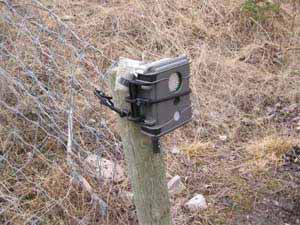
Figure 75. Photo. Remote digital infrared-operated camera (Credit: Tony Clevenger/WTI).
Benefits
Unambiguous species identification; low labor cost; can be deployed during all seasons and in locations with running water; some (limited in North America) potential for differentiating individuals; permanent record; photos valuable for outreach to public.
Constraints
Low ability to detect all sizes of species - most effective for medium to large species; risk of theft; high initial cost.
Estimated Cost
High initial cost (but lower labor cost during surveys) of $550-$800 per camera (including protective, theft-resistant box and data cards).
Applications
Assess use/effectiveness of wildlife crossing structures (existing and proposed)
- Assess rate of wildlife at grade highway crossings (cameras deployed randomly)
- Assess rate of wildlife, at grade, highway crossings (cameras deployed at targeted locations)
- Monitor wildlife use of locations throughout and adjacent to the project area (cameras deployed at scent stations)
- Evaluate effectiveness of jump-outs (cameras deployed on top of jump-outs).
REMOTE DIGITAL STILL OR VIDEO CAMERAS DEPLOYED SPECIFICALLY FOR EVALUATING AT GRADE, WILDLIFE HIGHWAY CROSSINGS
Remote cameras can also be deployed along roadsides with "active-type" sensors composed of "break the beam" components. When an animal approaching the side of the highway breaks the beam between two sensors, a photo is taken or a video camera is turned on. Sensors can be separated by up to 100 ft, can be combined to monitor longer stretches, and can be set-up to fire multiple still cameras.
Benefits
Unambiguous species identification; low labor cost; permanent record; photos/video valuable for outreach to public.
Constraints
High level of complexity with setup and untested for this purpose; likely difficulty in discerning species at greater distances from camera location; low ability to detect all sizes of species - most effective for larger species; only detects crossing attempts, not successful crossings; risk of theft; high initial cost.
Estimated Cost
High initial cost (but lower labor cost during surveys) of $1000-$2000 per 200 ft stretch of road (including protective, theft-resistant box and data cards).
Applications
- Assess rate of at grade, wildlife highway crossings (cameras deployed randomly)
- Assess rate of at grade, wildlife highway crossings (cameras deployed at targeted locations).
TRACK BEDS
Track beds are constructed from a mixture of sand and silt deposited in a linear bed (typically about 2 yards in width) across culvert entrances or within the culvert itself as Figure 76 shows. Such beds are raked smooth and are generally checked every three to four days for tracks that indicate animal crossings: species, direction of travel, number of individuals, etc.
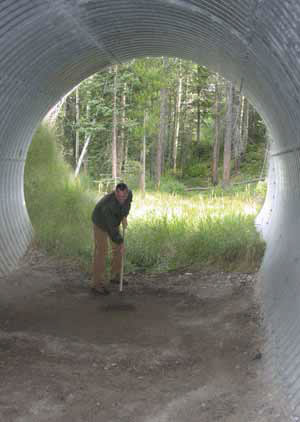
Figure 76. Photo. Raking of track bed in culvert Banff National Park, Alberta (Credit: Tony Clevenger/WTI).
Benefits
Detect wide-variety of animal sizes (but generally coyote-size and larger); can provide back-up in case remote camera malfunctions or is stolen; relatively low up-front cost; Generally not affected by weather events that may obliterate tracks if structure is covered (e.g., underpass or culvert).
Constraints
Unable to deploy at locations with running water unless natural banks or engineered pathways are constructed in structures; occasionally problems with species identification; trampling of tracks (i.e., many overlapping tracks) can make interpretation difficult if not checked regularly; difficult to confirm that an individual animal passed completely through the structure or simply crossed the bed and returned.
Estimated Cost
Low cost (field vehicle and labor cost during surveys for personnel to check track pads regularly); personnel costs: $1300 for one month of monitoring @ 10 days of work per month @$130/day [$16/hr]; low equipment costs: rake, personal data assistant (PDA), digital camera, tape measure, field guide to animal tracks.
Applications
- Assess use/effectiveness of wildlife crossing structures (existing and proposed)
- Monitor wildlife use of locations throughout and adjacent to the project area (beds deployed as round "plots" and used in conjunction with a bait or scent lure
- Evaluate effectiveness of jump-outs (beds deployed on top and around the base of jump- outs).
TRACK BEDS DEPLOYED SPECIFICALLY FOR EVALUATING AT GRADE, WILDLIFE HIGHWAY CROSSINGS
Track beds can also be deployed along highway shoulders or in medians, providing a means to detect animals approaching the side of the highway or in the median.
Benefits
Detect wide variety of large mammals; can provide back-up in case remote camera malfunctions or is stolen;
Constraints
Unable to deploy at locations with little or no shoulder, where shoulder is steep or inundated with water, where shoulder is mostly vegetation, or in locations where monitoring and maintenance would be a safety risk to personnel; ambiguous species identification common; tracks cannot easily be collected and reviewed later; over-tracking (i.e., many overlapping tracks) can make interpretation difficult; difficult to confirm that animals leaving tracks actually attempted to cross highway or had simply crossed the bed and returned; only detects crossing attempts, not successful crossings; installation requires heavy machinery and coordination with Department of Transportation; high labor cost (must be maintained frequently).
Estimated Cost
High initial cost: $350 - $400 for materials and installation of one 100 ft bed (depends largely on access to sand and machinery); low operational cost: labor cost to conduct surveys=$1300 for one month of monitoring @ 10 days of work per month @ $130/day [$16/hr]; low equipment costs: rake, PDA, digital camera, tape measure, field guide to animal tracks (same as "track bed" monitoring above).
Applications
- Assess rate of at grade, highway wildlife crossings (cameras deployed randomly)
- Assess rate of at grade, highway wildlife crossings (cameras deployed at targeted locations).
UNENCLOSED TRACK PLATES
A metal plate covered partially with a thin layer of soot and then a section of light-colored contact paper with the sticky side up. Animals crossing the plate first walk over soot and then track the soot on the contact paper, leaving a print as captured in Figure 77. Plates are checked for prints every five to seven days and soot/paper is replaced. Contact paper with prints is removed and stored in plastic page protector.
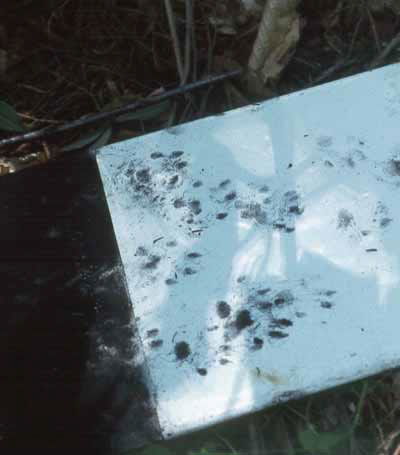
Figure 77. Photo. Sooted track plate with tracks of small and medium-sized mammals (Credit: Robert Long/WTI).
Benefits
Detect wide-variety of animal sizes; provides a high-resolution print that makes identification of species likely; print can be collected, reviewed later, and stored indefinitely; low initial cost.
Constraints
Unable to deploy at locations with running water; difficult to deploy effectively in wide structures (>6 ft); must be deployed under cover or in very dry climate conditions.
Estimated Cost
Low up-front cost (but labor cost during surveys); $200 for materials; $800 for one month of monitoring (6 days of work per month @ $16/hr).
Applications
- Assess use/effectiveness of smaller wildlife crossing structures (existing and proposed)
- Monitor wildlife use of locations throughout and adjacent to the project area (used in conjunction with a bait or scent lure).
ENCLOSED TRACK PLATES
Similar to an unenclosed track plate (Figure E-3) but where the metal plate is typically smaller and inserted (with soot and contact paper) into a rectangular or triangular enclosure. Enclosed plates permit deployment in light rain or snow and can also be fitted with hair collection devices.
Benefits
Readily used by many smaller species (e.g., fisher, marten, raccoon, and smaller); provides a high-resolution print that makes identification of species likely; print can be collected, reviewed later, and stored indefinitely; ability to incorporate hair collection devices; protected from some weather; low up-front cost.
Constraints
Unable to deploy at locations with running water; limited to small species; can only be deployed in very small structures unless used with bait or scent lures.
Estimated Cost
Low up-front cost (but labor cost during surveys); $200 for materials; $800 for one month of monitoring (6 days of work per month @ $16/hr).
Applications
- Assess use/effectiveness of smaller wildlife crossing structures (existing and proposed)
- Monitor wildlife use of locations throughout and adjacent to the project area (used in conjunction with a bait or scent lure).
HAIR COLLECTION DEVICES WITH DNA METHODS
Various hair collection devices are available and selection typically depends on species of interest and specific objectives. Most hair collection at crossing structures is conducted via two barbed-wire strands stretched across the mouth of the structure at heights appropriate for the target species of interest as sketched in Figure 78.
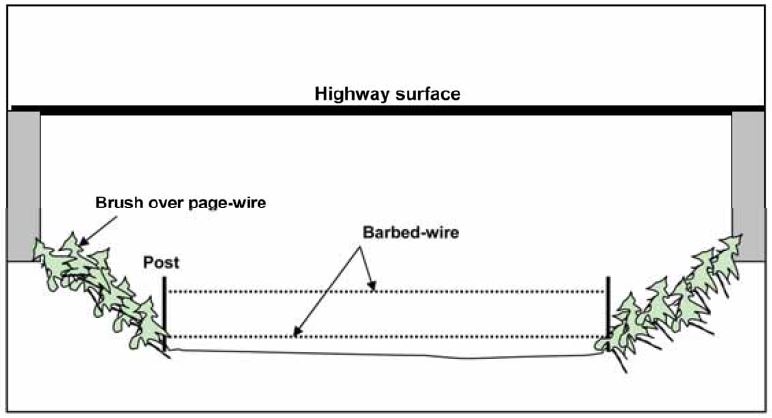
Figure 78. Schematic. Diagram of hair-snagging system at a wildlife underpass used in DNA-based research of population-level benefits of crossing structures (Source: Tony Clevenger/WTI).
View larger version of Figure 78.
Animals using the crossing structure are forced to slide under or between the wires, or step over the top wire, and in the process leave tufts of snagged hair on one or more barbs as Figure 79 shows. If enclosed track plates are used for small and medium mammals, hair snagging devices can be installed that will collect hair in addition to prints. Other options for locating hair snares within or adjacent to crossing structures are available, but most would require a scent lure to entice animals to either rub or interact with a device.
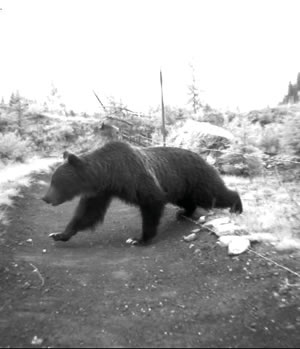
Figure 79. Photo. Grizzly bear passing through hair-snagging device at wildlife overpass in Banff National Park, Alberta (Credit: Tony Clevenger/WTI).
Benefits
Provide both confirmation of animal presence and DNA sample for further analyses; low up- front cost and fairly low labor cost to maintain.
Constraints
Fairly species-specific; some DNA analyses can be relatively expensive; should be used in conjunction with track bed/plate or remote camera.
Estimated Cost
Depends on objectives - identifying a hair sample to species can cost from $15 - 25, whereas more detailed DNA analyses (e.g., microsatellite analysis to identify individuals) can cost from $50 - $120 per sample. In all cases, per-sample costs are highly dependent on the sample quality and specific lab.
Applications
- Assess use/effectiveness of wildlife crossing structures (existing and proposed)
- Monitor wildlife use of locations throughout and adjacent to the project area (used in conjunction with a bait or scent lure)
- Determine relatedness of individuals using crossing structures
- Determine whether numerous crossings are by the same individual or by many individuals.
- Collection of DNA samples for Tier 2 objectives.
TRAP, TAG, AND RECAPTURE/RESIGHT
Animals such as amphibians/reptiles and small mammals that are relatively easy to capture can be trapped or hand-captured and tagged as shown in Figure 80, on both sides of the highway. Subsequent capture efforts can permit the estimation of highway crossing rates.
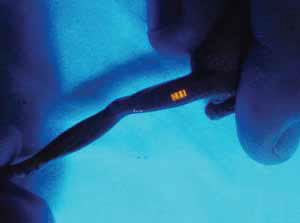
Figure 80. Photo. Digital barcode tag for frogs (Source: Steve Wagner/CWU).
Benefits
Only effective method for monitoring some species (e.g., amphibians, reptiles, small mammals); direct confirmation that animals have successfully crossed highway; relatively low cost for some species.
Constraints
Difficult to confirm whether individuals are crossing at grade or through crossing structures; labor intensive; potential negative effects on captured/tagged individuals; typically results in few recaptures unless number of tagged individuals is very large.
Estimated Cost
Low to moderate, depending on species.
Applications
- Assess use/effectiveness of wildlife crossing structures (existing and proposed)
- Assess rate of at grade, wildlife highway crossings (in locations without crossing structures)
- Monitor wildlife use of locations throughout and adjacent to the project area
SNOW TRACK TRANSECTS
Snow tracking can be used to detect species that are active during winter. Snow tracking can be conducted while driving the road, traveling off-road parallel to and at close distances (e.g., within 150 ft) from the roadside, or on secondary roads or off-road transects away from the road.
Benefits
Fairly high effectiveness for detecting some species; easily tailored for use in many locations; low cost.
Constraints
Limited to locations with consistent snowfall; short time window to conduct surveys after each snowfall; difficult to schedule surveys; can be labor-intensive to collect substantial amounts of data during relatively few snowfalls (i.e., many personnel may be required to cover multiple transects within a short timeframe); difficult to confirm species unless track and snow conditions are ideal; tracks cannot easily be collected and reviewed later; traffic safety concerns when conducting road surveys;
Estimated Cost
Low to moderate; limited to cost of labor, one-time purchase of skis/snowshoes, and winter safety and avalanche training.
Applications
- Assess use/effectiveness of wildlife crossing structures (existing and proposed)
- Assess rate of at grade, wildlife highway crossings
- Monitor wildlife use of locations throughout and adjacent to the project area (used in conjunction with a bait or scent lure)
SCAT DETECTION DOGS WITH DNA METHODS
Professionally trained dogs can now be used to effectively and efficiently locate scats from target species. A single dog, working with a handler and an "orienteer," as Figure 81 shows, typically searches a predefined transect or grid. Located scats are collected for DNA analysis.
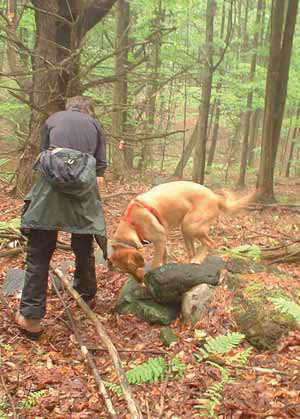
Figure 81. Photo. Scat-detection dog working to locate scat (Credit: Robert Long/WTI). Benefits
High degree of effectiveness and cost efficiency (i.e., cost per detection); does not require site preparation before survey; can be easily tailored to specific locations and can quickly adapt to changes in protocol; can be used in most conditions and on most types of topography; provides scat sample for multiple analyses (e.g., species and individual identification, diet, hormone analysis).
Constraints
High initial cost; substantial logistical issues; each dog limited to detecting a fairly discrete number of target species; in most cases requires DNA confirmation, or at least some DNA testing.
Estimated Cost
High up-front cost for training and dog leasing; actual cost depends largely on whether dogs are leased or purchased and whether handlers are hired professionals or are existing personnel that can be trained.
Applications
- Monitor wildlife use of locations throughout and adjacent to the project area
- Collection of DNA samples for Tier 2 objectives.
GPS COLLARING
Some species can be captured and fitted with collars containing a GPS tracking device. Very high-resolution data on movements are recorded and either remotely downloaded by researchers or, more often, downloaded after the collar has either been shed or recovered on recapture.
Benefits
Very high resolution data allows assessment of fine-scale movement and reaction to crossing structures; ability to collect additional data such as mortality and behavioral data; ability to collect information on genetics and demographic parameters of population if sample sizes are large.
Constraints
High initial cost and capture of animals is very labor intensive; substantial logistical issues; generally results in small sample sizes which may not be representative of populations; potential negative effects on captured/tagged individuals.
Estimated Cost
High initial cost for purchase of GPS collars and animal capture; actual cost depends on how long the collars stay on the animal; occasional malfunction of GPS transmitting and receiving system.
Applications
- Assess use/effectiveness of wildlife crossing structures (existing and proposed)
- Assess rate of at grade, wildlife highway crossings
- Monitor wildlife use of locations throughout and adjacent to the project area
- Evaluate effectiveness of wildlife fencing.
DOT MAINTENANCE CREW REPORTING
Data on road-killed wildlife are currently collected during regular work conducted by DOT highway crews. After highway construction is completed, maintenance crews would also be asked to collect data on fence condition and to report wildlife intrusions on the highway right-of- way. Data recording is facilitated by a Roadkill Observation Collection System (ROCS) - a combined PDA - GPS device shown in Figure 82. Regular contacts by monitoring personnel with road crews to emphasize the importance of collecting data will be important to ensure consistent survey effort.
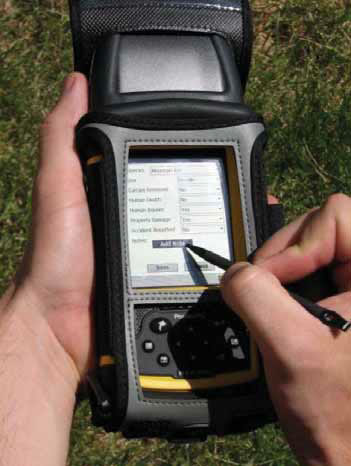
Figure 82. Photo. Roadkill Observation Collection System (ROCS) (Credit: WTI).
Benefits
Can be tailored to include any species that can be recognized as either live or road-killed wildlife; DOT Maintenance crews are regularly traveling the highway and may receive direct reports of wildlife - vehicle collisions or carcasses.
Constraints
Method requires both spatially and temporally consistent survey effort by crews for data collected to be valid and useful for analyses.
Estimated Cost
Low - consisting of training DOT Maintenance crews to operate ROCS units and routine refresher training and meeting with crews to encourage regular use of ROCS units.
Applications
- Assess wildlife - vehicle collision rate
- Evaluate effectiveness of wildlife fencing
STATE PATROL REPORTING
Currently, in many states and provinces information on wildlife - vehicle collisions resulting in vehicle damage (>$1000) is collected by State patrols and may also be requested from other agencies that collect such data.
Benefits
Effort is consistent and will likely remain so into the future; cost is relatively minimal; species monitored are limited; can be cross-referenced with DOT maintenance crew reports and monitoring personnel.
Constraints
Mortality data are limited to collisions with > $1000 in property damage (generally Elk and Deer).
Estimated Cost
Negligible.
Applications
- Assess wildlife - vehicle collision rate
- Evaluate effectiveness of wildlife fencing
MONITORING PERSONNEL ROAD-KILL AND FENCE INTEGRITY SURVEYS
Monitoring personnel can collect information on wildlife - vehicle collisions during systematic drives through the project area (e.g., every 1-7 days). Fencing can be visually examined during regular course of work and field-examined twice per year by DOT maintenance crews and/or monitoring personnel.
Benefits
Provides spatially and temporally consistent effort that can be closely controlled; all species coyote-size and larger can be monitored.
Constraints
Relatively high rate of survey (e.g., daily or minimally twice per week) may be required to locate carcasses, especially of small animals; does not detect instances when animals are injured and die undetected at a later time, or where carcasses leave the roadway and are not seen; single drive through may provide little chance of detecting carcasses; limited number and distribution of safe-stopping locations may make carcass identification impossible; slow required driving speeds often unsafe.
Estimated Cost
Low during seasons when other survey work is being conducted; moderate at other times.
Applications
- Assess wildlife - vehicle collision rate
- Evaluate effectiveness of wildlife fencing
APPENDIX F - OTHER HANDBOOKS AND GUIDELINES UNITED STATES
Bissonette, J.B. 2007. Evaluation of the use and effectiveness of wildlife crossings. National Cooperative Highway Research Program (NCHRP) 25-27 final report. Transportation Research Board, Washington DC.
Huijser, M.P., J. Fuller, M.E. Wagner, A. Hardy, & A.P. Clevenger. 2007. Animal - vehicle collision data collection: a synthesis of highway practice. National Cooperative Highway Research Program Synthesis 370. Transportation Research Board, Washington, D.C.
Huijser, M.P., A. Kociolek, P. McGowen, A. Hardy, A.P. Clevenger, and R. Ament. 2007b. Wildlife - vehicle collision and crossing mitigation measures: A toolbox for the Montana Department of Transportation. Report no. FHWA/MT-07-002/8117-34. Helena, MT.
Huijser, M.P., P. McGowen, J. Fuller, A. Hardy, A. Kociolek, A.P. Clevenger, D. Smith and R. Ament. 2007. Wildlife - vehicle collision reduction study. Report to US Congress. U.S. Department of Transportation, Federal Highway Administration, Washington D.C.
Southern Rockies Ecosystem Project. No date. Safe passage: A users guide to developing effective highway crossings for carnivores and other wildlife. Southern Rockies Ecosystem Project, Denver, Colorado.
EUROPE
English Language
Iuell, B. (ed.). 2003. Wildlife and traffic: A European handbook for identifying conflicts and designing solutions. KNNV Publishers, Utrecht, The Netherlands.
Trocme, M. (ed.). 2003. Habitat fragmentation due to transportation infrastructure: The European review. European Commission, Directorate General for Research, COST Action 341. Publication EUR 20721. Luxembourg.
Other Languages
Ministerio de Medio Ambiente. 2006. Prescripciones tecnicas para el diseno de pasos de fauna y vallados perimetrales. Documentos para la reduccion de la fragmentacion de habitats causada por infraestructuras de transporte, numero 1. Ministerio de Medio Ambiente, Madrid, Spain.
Rosell, C. and Velasco Rivas, J. 1999. Manual de prevencio i correcio dels impactes de les infrastructures viares sobre la fauna. Documents dels Quaderns de Medi Ambient, 4. Generalitat de Catalunya, Department de Medi Ambient. 95pp. Barcelona, Spain.
Service d'etudes sur les transport, les routes et leurs amenagements (SETRA) et Centre d'Etudes Technique de l'Equipement (CETE) 2006. Route et passage à faune. 40 ans d'évolution. Rapport. 57 p.
APPENDIX G - PROFESSIONAL AND TECHNICAL JOURNALS GENERAL ROAD ECOLOGY
Biological Conservation
Canadian Journal of Civil Engineering
Conservation Biology
Earth Surface Processes and Landforms
Ecological Engineering
Ecology and Society (online)
Environmental Management Journal of Applied Ecology
Journal of Environmental Management
Journal of Environmental Planning
Landscape Ecology
Landscape and Urban Planning
Transportation Research Record
Wildlife Biology
Wildlife Society Bulletin (now Journal of Wildlife Management)
TERRESTRIAL WILDLIFE
Biological Conservation
Canadian Journal of Zoology
Conservation Biology Journal of Applied Ecology
Journal of Wildlife Management
Landscape Ecology
Landscape and Urban Planning
Transportation Research Record
Wildlife Biology
Wildlife Society Bulletin (now Journal of Wildlife Management)
TRAFFIC SAFETY
Accident Analysis and Prevention
Canadian Journal of Civil Engineering
Ecological Engineering
Ecology and Society (online)
Journal of Safety Research
Transportation Research Record
Wildlife Society Bulletin (now Journal of Wildlife Management)
Previous Chapter « Table of Contents » Next Chapter
![]()


![]()







 Figure 38. Photo. Ropes extending out from canopy crossing to forest canopy (Credit: Tony Clevenger).
Figure 38. Photo. Ropes extending out from canopy crossing to forest canopy (Credit: Tony Clevenger). 








































